Gediktepe Project - Balıkesir Province, Turkey
NI 43-101 Royalty Technical Report
Prepared for:

Prepared by:

DAMA Engineering Inc.
Ankaralılar Caddesi 2562 Sokak 1/14A, Ankara-Turkey
Qualified Persons:
Mustafa ATALAY, M.Sc., CPG.
Senior Geologist, Dama Engineering
Metin ALEMDAR, M.Sc., MIMMM
Senior Mining and Mineral Processing Engineer, Dama Engineering
Selim YILMAZ, M.Sc., MIMMM
Senior Mining and Mineral Processing Engineer, Dama Engineering.
Arif Umutcan GELİŞEN, B.Sc., MIMMM
Senior Mining and Mineral Processing Engineer, Dama Engineering
Effective Date: February 1, 2022
Report Date: March 21, 2022
Table of Contents
| 1. Summary | 1 |
| 1.1 Introduction | 1 |
| 1.2 Property Description and Ownership | 1 |
| 1.3 Accessibility, Climate, Local Resources, Infrastructure and Physiography | 3 |
| 1.4 Geology, Mineralization, and Deposit Type | 3 |
| 1.4.1 Geology | 3 |
| 1.4.2 Mineralization and Deposit Type | 4 |
| 1.5 History | 5 |
| 1.5.1 Ownership History | 5 |
| 1.5.2 Historical Exploration and Drilling | 5 |
| 1.5.3 Historical Grade Estimation | 5 |
| 1.5.4 Historical Mineral Resources | 5 |
| 1.5.5 Historical Mineral Reserves | 6 |
| 1.5.6 Historical Mining Methods | 7 |
| 1.5.7 Historical Recovery Methods | 8 |
| 1.5.8 Historical Site Infrastructure | 8 |
| 1.5.9 Historical Environmental Studies, Permitting and Social or Community Impact | 8 |
| 1.5.10 Historical Other Relevant Data and Information | 8 |
| 1.5.11 Historical Conclusions and Recommendations | 8 |
| 1.6 Data Verification | 9 |
| 1.7 Conclusions and Recommendations | 9 |
| 2. Introduction | 10 |
| 2.1 Terms of Reference | 10 |
| 2.2 Sources of Information | 10 |
| 3. Reliance on Other Experts | 12 |
| 4. Property Description and Location | 13 |
| 4.1 Project Ownership | 13 |
| 4.2 EMX's Royalty Interests | 14 |
| 4.3 Other Royalties, Permits and Encumbrances | 14 |
| 4.3.1 Government Royalty | 15 |
| 4.3.2 Forestry and Other Permits | 16 |
| 4.4 Other Factors | 16 |
| 5. Accessibility, Climate, Local Resources, Infrastructure and Physiography | 17 |
| 5.1 Location and Access | 17 |
i
| 5.2 Physiography | 19 |
| 5.3 Climate | 20 |
| 5.4 Local Resources | 20 |
| 5.5 Infrastructure | 21 |
| 6. History | 23 |
| 6.1 Prior Ownership and Ownership Changes | 23 |
| 6.2 Licenses and Permits | 23 |
| 6.3 Historical Reports | 24 |
| 6.3.1 Historical Exploration and Drilling | 24 |
| 6.3.2 Historical Mineral Processing and Metallurgical Testing | 26 |
| 6.3.3 Historical Block Model Resource Estimation Methods | 27 |
| 6.3.4 Historical Mineral Resources | 28 |
| 6.3.5 Historical Mineral Reserves | 31 |
| 6.3.6 Historical Mining Methods | 32 |
| 6.3.6.1 General Overview of Historical Production Schedules | 32 |
| 6.3.7 Historical Recovery Methods | 33 |
| 6.3.8 Historical Site Infrastructure | 37 |
| 6.3.9 Historical Environmental Studies, Permitting and Social or Community Impact | 37 |
| 6.3.9.1 Historical Other Relevant Data and Information | 38 |
| 6.3.9.2 Pre-Feasibility Study and Gediktepe Project Oxide Technical Report | 38 |
| 6.3.9.3 Historical Mineral Resources Recommendations | 38 |
| 6.3.9.4 Historical Mining Method Recommendations | 39 |
| 6.3.9.5 Historical Process and Metallurgical Test work Recommendations | 39 |
| 6.3.9.6 Historical Site Infrastructure Recommendations | 40 |
| 7. Geological Setting and Mineralization | 41 |
| 7.1 Regional Geology | 41 |
| 7.2 Deposit Geology | 43 |
| 7.2.1 Dacite and Pyroclastics (Lower-Middle Miocene) | 45 |
| 7.2.2 Calcshist (Upper Paleozoic) | 46 |
| 7.2.3 Quartz-Feldspar Schist (Upper Paleozoic) | 47 |
| 7.2.4 Chlorite-Sericite Schist (Upper Paleozoic) | 48 |
| 7.2.5 Quartz Schist (Upper Paleozoic) | 50 |
| 7.3 Mineralization | 50 |
| 7.3.1 Gossan (Oxide Mineralization) | 51 |
| 7.3.2 Massive Pyrite (MPy) | 53 |
| 7.3.3 Massive Pyrite-Magnetite (MPyMag) | 54 |
| 7.3.4 Enriched (Enrch) | 54 |
ii
| 7.3.5 Disseminated Sulfide Mineralization (Tr-Sulp) | 55 |
| 7.4 Structure | 55 |
| 8. Deposit Types | 57 |
| 9. Exploration | 58 |
| 10. Drilling | 58 |
| 11. Sample Preparation, Analyses and Security | 58 |
| 12. Data Verification | 59 |
| 12.1 Site Visits | 59 |
| 12.2 Limitations | 59 |
| 12.3 QP's Comment | 60 |
| 13. Mineral Processing and Metallurgical Testing | 61 |
| 14. Mineral Resource Estimates | 61 |
| 15. Mineral Reserve Estimates | 61 |
| 16. Mining Methods | 61 |
| 17. Recovery Methods | 61 |
| 18. Project Infrastructure | 61 |
| 19. Market Studies and Contracts | 62 |
| 20. Environmental Studies, Permitting, and Social or Community Impact | 62 |
| 21. Capital and Operating Costs | 62 |
| 22. Economic Analysis | 62 |
| 23. Adjacent Properties | 62 |
| 24. Other Relevant Data and Information | 62 |
| 25. Interpretation and Conclusions | 63 |
| 26. Recommendations | 65 |
| 27. References | 67 |
| 28. Certificate of Qualified Person | 68 |
iii
List of Figures
| Figure 1-1: Project Area Location Map | 2 |
| Figure 4-1: Current Gediktepe Operating License | 14 |
| Figure 5-1: Project Location Map | 17 |
| Figure 5-2: Paved Road | 18 |
| Figure 5-3: Gediktepe Project Area and By-pass Road. Pink color shows the by-pass road, constructed in 2017 | 19 |
| Figure 5-4: Aerial Photograph of Gediktepe Field Camp | 21 |
| Figure 5-5: Gediktepe Topography and Water Supply Route. Contoured at 10 m intervals | 22 |
| Figure 6-1: Historical Drillhole Location Plan - PFS19 Drillhole Dataset | 26 |
| Figure 6-2: Historical PFS19 Oblique View of Mineralization Solid Interpretations | 28 |
| Figure 6-3: Historical TR20 Flowsheet for Oxide Processing | 35 |
| Figure 6-4: Historical PFS19 Flowsheet for Sulfide Processing | 36 |
| Figure 7-1: Tectonic Map of Turkey | 41 |
| Figure 7-2: Gediktepe Regional Geology | 42 |
| Figure 7-3: Regional Stratigraphic Column | 43 |
| Figure 7-4: 1:1,000 Scale Project Geological Map | 44 |
| Figure 7-5: Dacite Features (A): Dacite dome Karadikmen Hill, (B): Flow structure in dacite, (C) and (D): Opal filling in voids | 46 |
| Figure 7-6: Dacite Hand Specimen. Grey vitreous matrix incl. quartz, biotite, and feldspar phenocryst | 46 |
| Figure 7-7: Calcshist in Outcrop. Fındıkalanı Ridge | 47 |
| Figure 7-8: Quartz-Feldspar Schist in Outcrop. Around Büyük Yellice Hill and the Kaynarsu stream | 47 |
| Figure 7-9: Quartz-Feldspar Schist Core Photograph | 48 |
| Figure 7-10: Chlorite-Sericite Schist in Outcrop | 49 |
| Figure 7-11: Chlorite-Sericite Schist Core Photograph | 49 |
| Figure 7-12: Chlorite-Sericite Schist Altered to Tr-Sulf Core Photograph | 49 |
| Figure 7-13: Quartz Schist Containing Quartz Porphyroblasts in Outcrop. Southeast of Alçakgedik Hill | 50 |
| Figure 7-14: Quartz Schist Core Photograph | 50 |
| Figure 7-15: Gossan in Outcrop | 51 |
| Figure 7-16: Typical Profile of Mineralization from Oxide to Sulfide | 52 |
| Figure 7-17: Mineralization Profile at Gediktepe | 52 |
| Figure 7-18: High-Grade Gossan Mineralization Drill Core | 53 |
| Figure 7-19: Massive Pyrite Drill Core | 54 |
| Figure 7-20: Magnetite Aligned with Schistosity in Core | 54 |
| Figure 7-21: Enriched Mineralization in Drill Core - Blue Color | 55 |
| Figure 7-22: Chlorite-Sericite Schist with Pyrite Veining in Drill Core | 55 |
| Figure 8-1: Vertical Section of an Idealized Convex MS Deposit | 57 |
iv
List of Tables
| Table 1.1: Mineralization Types | 4 |
| Table 1.2: Historical Gediktepe PFS19 Mineral Resources | 6 |
| Table 1.3: Historical Gediktepe PFS19 Mineral Reserves | 7 |
| Table 4.1: Government Base Royalty Rate by Commodity and Metal Price | 15 |
| Table 4.2: Royalty Rate by Commodity and Metal Price | 15 |
| Table 6.1: Summary of PFS19 Drillhole Dataset to March 21, 2018 | 25 |
| Table 6.2: Historical Gediktepe PFS19 Mineral Resources - All Classifications | 29 |
| Table 6.3: Historical Gediktepe PFS19 Mineral Reserves | 31 |
| Table 7.1: Mineralization Type Names | 51 |
v
1. Summary
1.1 Introduction
EMX Royalty Corporation (TSX Venture: EMX; NYSE American: EMX) ("EMX" or the "Company") entered into an agreement (the "Royalty Purchase Agreement") dated July 29, 2021, with SSR Mining Inc. and certain of its subsidiaries ("SSR Mining") to purchase a portfolio of royalty interests and deferred payments (the "Royalty Portfolio"). The Royalty Portfolio includes the Gediktepe Project Net Smelter Return ("NSR") royalties (the "Gediktepe Royalties") on the oxide and sulfide mineralized zones of the Gediktepe polymetallic massive sulfide project in Western Turkey (the "Project"). The Project became material to EMX upon closing of the purchase of the Royalty Portfolio on October 21, 2021. EMX is required by Canadian Securities Administrators ("CSA") National Instrument 43-101 ("NI 43-101") to prepare a Technical Report on the Project with respect to the Gediktepe Royalties.
EMX holds royalty interests (not direct ownership) in the Project. Mining companies are not (typically) required to, and as a matter of practice do not normally disclose detailed information to companies that hold a royalty interest in their operations unless legally or contractually mandated to do so. EMX has requested all the current technical data from the private Turkish operator, Polimetal Madencilik Sanayi ve Ticaret A.S. ("Polimetal"), in order to conduct a detailed independent assessment of Gediktepe for this Technical Report. However, EMX has not yet received this data, and according to the underlying royalty agreement, does not have data rights beyond onsite reviews. EMX will continue to request the Project data directly from Polimetal.
There have been two previous Technical Reports describing the Project filed on SEDAR: the first is titled "Technical Report - Prefeasibility Study - Gediktepe Project, Balıkesir Province, Turkey" with an effective date of June 1, 2016 ("PFS16") prepared by Resource Development Inc., SRK Consulting (U.S.) Inc. and Independent Mining Consultants, Inc. for Alacer Gold Corp. ("Alacer") and Polimetal, and the second is titled "Gediktepe Prefeasibility Study" ("PFS19") dated April 3, 2019 with an effective date of March 26, 2019 prepared by OreWin Pty. Ltd. ("OreWin") for Alacer. These reports document the outcome of PFS-level technical work on Gediktepe's oxide and sulfide polymetallic mineralized zones performed on behalf of Polimetal, which was owned 50% by Lidya Madencilik San. ve Tic. A.Ş., a private Turkish company ("Lidya"), and 50% by Alacer, formerly a reporting issuer in Canada. The Project and Polimetal are now 100% controlled by Lidya. Lidya has also provided EMX with a 2020 internal report titled "Gediktepe Project Oxide Technical Report" ("TR20") with an effective date of March 1, 2020. The TR20 report was largely taken from PFS19, although updates and refinements to the oxide processing flowsheet were proposed. Unless otherwise specified, the contents of this Technical Report have been excerpted from, or based upon, the aforementioned PFS16, PFS19, and TR20 reports. In addition, information and Project updates verbally communicated by Lidya during two onsite field visits were noted, and where appropriate, used to provide more recent context for the status of the Project.
For simplicity in this document, references to Lidya also refer to Polimetal, the operating entity, when citing information dated after July 2019, when Lidya acquired 100% interest in Polimetal.
1.2 Property Description and Ownership
The Gediktepe Project is located in the Balıkesir province of Western Turkey (Figure 1-1). The UTM Zone 35N, European Datum coordinates of the approximate center of the Project are 636,000E, 4,358,000N.
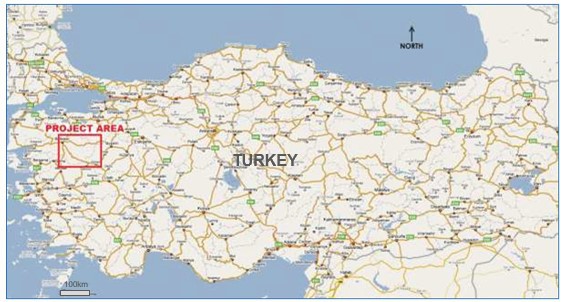
Figure from OreWin, 2019
Figure 1-1: Project Area Location Map
EMX completed the purchase of the Gediktepe Royalties based upon the terms and conditions of the Royalty Purchase Agreement with SSR Mining and certain of its subsidiaries to purchase the Royalty Portfolio. The Royalty Portfolio included the Gediktepe Royalties consisting of: (i) a perpetual 10% NSR royalty over metals produced from the oxide zone (predominantly gold and silver) after cumulative production of 10,000 gold-equivalent oxide ounces; and (ii) a perpetual 2% NSR royalty over metals produced from the sulfide zone (predominantly copper, zinc, lead, silver, and gold), payable after cumulative production of 25,000 gold-equivalent sulfide ounces (gold equivalent as referenced from the 2019 Share Purchase Agreement between Alacer and Lidya).
The following Project license and permits have been confirmed as being current and in good standing.
The General Directorate of Mining and Petroleum Affairs (GDMPA) approved the merging of Operating License (OL) 20054077 and Exploration License (EL) 201400291 into one OL (RN 85535) on July 29, 2016. RN 85535 is valid until June 23, 2036. The Gediktepe OL (RN 85535) covers a total area of 1,486.99 ha and is held by Polimetal (now wholly owned by Lidya).
On February 21, 2018, the GDMPA also approved Polimetal's application for a production permit for clay and aggregate for three locations within RN 85535.
The Gediktepe mining licenses do not have any associated royalties to a third party other than EMX's Gediktepe Royalties and a government royalty, which consists of royalty rates defined by commodity and metal price.
As of the effective dates of the PFS19 and TR20 reports, a series of final permits were pending in anticipation of a follow-on Feasibility Study and initiation of construction. However, it is known from site visits conducted by DAMA in 2021 that Project construction and initial mining of the oxide phase of the Project had commenced, implying that the necessary permits had been received.
To DAMA's knowledge, there are no significant factors or risks that may affect access, title, or the right ability to perform work on the Project, and by extension Lidya's ability to meet its royalty payment obligations to EMX.
1.3 Accessibility, Climate, Local Resources, Infrastructure and Physiography
The Project is located 67 km (air distance) southeast of Balıkesir Province center and 38 km east-southeast of the Bigadiç township. It is accessed along 102 km of paved road from the city of Balıkesir (population 1,189,075) on highway D555 through the town of Bigadiç (population 48,470). The closest settlements to the Gediktepe Project site are the Hacıömerderesi neighborhood, the Aşıderesi neighborhood, affiliated with the Hacıömerderesi neighborhood, and the Meyvalı neighborhood.
The terrain at the Project is mountainous with steep erosional valleys. Elevations in the Project area range from 974-1,482 m above sea level (masl). Coniferous trees cover most of the Project site, with occasional open meadows in areas of less-steep terrain.
The local climate is hot and arid during the summer and warm during the fall. There is snow from December through February but typically not as a significant accumulation. Spring is often the rainy period.
The main economic income sources in the area are forestry, agriculture, and animal husbandry.
As of the effective dates of PFS19 and the TR20 reports, an adequate water supply system needed to be established for the Project as there was no developed system in the area capable of supporting a project of Gediktepe's size. From DAMA's site visits, it appears that Lidya has been taking the steps to develop a pipeline to provide the necessary water for the Project.
A 39.6 km-long 34.5 kV power transmission line (PTL) was constructed between Dursunbey substation and Kürendere to provide power to the Project. This PTL will provide adequate electrical power for site operations.
Given Gediktepe's physiographic and climatic conditions DAMA believes that year-round operations of the Project are possible. Adequate local manpower is available to support mining operations. To DAMA's knowledge, with adequate power and access to suitable areas for Project infrastructure, the principal contingency requiring final confirmation of resolution is Polimetal's completion of the pipeline to provide an adequate water supply for the Project.
1.4 Geology, Mineralization, and Deposit Type
1.4.1 Geology
The Gediktepe regional geology comprises Upper Paleozoic metamorphic rocks and Lower to Middle Miocene intrusives and volcanics. These rocks are stratigraphically overlain by Triassic carbonates and fragmental units, Jurassic limestone, and an Upper Cretaceous ophiolitic mélange. Oligocene and Lower Miocene intrusions cut the Paleozoic metamorphic and Upper Cretaceous ophiolitic rocks, establishing in the region what is now called the Alaçam Mountains granites, which outcrop in an arc-shaped geometry over an area of nearly 30 km2. Lower Miocene volcanic rocks are positioned stratigraphically above Paleozoic to Upper Paleozoic metamorphics and Upper Cretaceous ophiolitic mélanges.
Upper Paleozoic metamorphics are the most common units at Gediktepe, with the stratigraphic sequence, from top to bottom, being:
- Dacite and Pyroclastic (top)
- Calcschist
- Feldspar-Quartz Schist
- Chlorite-Sericite Schist
- Quartz Schist (bottom)
The second-most common rocks at the Project are the Lower to Middle Miocene volcanics, observable around Karadikmen Hill, southwest of Gediktepe. These rocks are comprised of altered dacite-rhyodacites characterized by lava flows and pyroclastics.
The youngest units at the Project are mineralized gossan and ferricrete, along with talus, colluvium, and alluvium, all being weathering products of the host rock.
1.4.2 Mineralization and Deposit Type
The Project is a massive sulfide deposit hosted in schists. The sulfide zone is polymetallic with potentially economic values of zinc, copper, gold, and silver. The upper portions of the Gediktepe deposit have been weathered, leached, and oxidized by naturally occurring acidic surface water and ground water. The oxide zone hosts gold-silver mineralization, but is nearly devoid of base metals.
Mineralization at the Project is associated with greenschist facies units that are interpreted to represent massive sulfide deposition that was syngenetic with sedimentary units. These units are now elongated along a north-easterly trending structural zone that has been metamorphosed to schist. The massive sulfide-type mineralization occurs as lens-shaped units trending north-easterly and dipping at approximately 20° to 40° to the northwest. The major sulfide zone minerals are sphalerite and chalcopyrite. Pyrite is ubiquitous.
Potentially economic gold-silver-copper-zinc mineralization is present to varying degrees, and is divided into five main types, as summarized in Table 1.1.
Table 1.1: Mineralization Types
| Horizon | Mineralization Type |
| Oxide | Gossan |
| Sulfide | Massive Pyrite |
| Massive Pyrite-Magnetite |
| Enriched |
| Disseminated Sulfide |
| Table from OreWin, 2019 |
The units are cut by later north-westerly trending post-mineralization structures.
The characteristics of the Gediktepe mineralization have been interpreted as a convex-up massive sulfide type deposit, which implies a syngenetic style of sulfide mineralization. Subsequent weathering and oxidation are responsible for the development of the oxide and gossan horizons.
1.5 History
1.5.1 Ownership History
The Gediktepe mining licenses are held by Polimetal Mining Industry and Trade Inc., otherwise known as Polimetal Madencilik San. ve Tic. A.Ş., which was formed in 2011 as a joint venture (JV) company between Lidya (50%) and Alacer (50%). The Gediktepe deposit was discovered in 2012-2013 by the JV. Alacer entered into an agreement (the "2019 Share Purchase Agreement") with Lidya in July 2019 to sell its 50% non-operating ownership interest in the Project to Lidya, whereby Alacer retained the Gediktepe Royalties, consisting of a) a 10% NSR royalty on all oxide ore production, and b) a 2% NSR on all sulfide ore production. The sale to Lidya resulted in Lidya consolidating 100% control of Polimetal and the Gediktepe Project. Subsequently, Alacer and SSR Mining completed a merger transaction in September 2020, whereby Alacer became a wholly owned subsidiary of SSR Mining. EMX purchased the Gediktepe Royalties from SSR Mining upon closing of the Royalty Purchase Agreement on October 21, 2021.
1.5.2 Historical Exploration and Drilling
There were five phases of core (DD) and reverse circulation (RC) exploration drilling at Gediktepe, commencing in 2013 and ending in 2018. This resulted in 438 DD holes totaling 56,898 meters and 191 RC holes totaling 13,229 meters. Of the total drillhole database, a subset of drilling comprised of 624 DD and RC holes totaling 68,968 m was used for geological modelling and resource estimation work in the PFS19 report by OreWin.
1.5.3 Historical Grade Estimation
Historical resource block model grades were estimated using either ordinary kriging (OK) or inverse distance weighting to the power of two (ID2). Depending on the domain being estimated, composites of either 1 m or 2 m (notional) length were used. The modelled estimates were assessed for levels of geological confidence, and classified into Measured, Indicated, and Inferred categories, referencing CIM guidelines (CIM, 2014). The Mineral Resource tonnages and grades were reported using NSR cut-offs and constrained within an optimized pit.
1.5.4 Historical Mineral Resources
The PFS19 historical Measured, Indicated, and Inferred Mineral Resources and combined Measured plus Indicated Resources for the Project at specified NSR cut-offs are presented in Table 1.2. The more-detailed breakdown of Mineral Resources by mineralogy-type is included in Table 6.2.
Table 1.2 summarizes "Historical Estimates" within the meaning of NI 43-101. The source of the estimates is Section 14 of PFS19, as repeated in TR20. The historical estimates set forth in Table 1.2 do not use categories of mineral resources other than the ones set out in the CIM Definition Standards and Section 1.2 of NI 43-101. For further details on the parameters utilized in the estimates, the reader is referred to Section 14 of PFS19.
A qualified person has not performed sufficient work to classify the historical resource estimates as current mineral resources, and DAMA is not treating the historical estimates as current. Significant data compilation, confirmation drilling, re-sampling and data verification may be required by, or under the supervision of, a qualified person before the historical estimates can be classified as current mineral resources. The historical resource estimates are considered to be relevant and are presented for the purpose of describing the extent and nature of mineralization as presently understood. The historical resource estimates should not be relied upon until verified by a qualified person.
Table 1.2: Historical Gediktepe PFS19 Mineral Resources
| MEASURED | Tonnes
(kt) | Grade | Metal |
Au
(g/t) | Ag
(g/t) | Cu
(%) | Zn
(%) | Pb
(%) | Au
(koz) | Ag
(koz) | Cu
(kt) | Zn
(kt) |
| Total Oxide | - | - | - | - | - | - | - | - | - | - |
| Total Sulfide | 3,999 | 0.67 | 25.1 | 1.01 | 1.83 | 0.34 | 86 | 3,221 | 40 | 73 |
| Total Measured | 3,999 | 0.67 | 25.1 | 1.01 | 1.83 | 0.34 | 86 | 3,221 | 40 | 73 |
| | | | | | | | | | | |
| INDICATED | Tonnes
(kt) | Grade | Metal |
Au
(g/t) | Ag
(g/t) | Cu
(%) | Zn
(%) | Pb
(%) | Au
(koz) | Ag
(koz) | Cu
(kt) | Zn
(kt) |
| Total Oxide | 2,674 | 2.71 | 66.3 | 0.1 | 0.1 | 0.47 | 233 | 5,703 | 3 | 3 |
| Total Sulfide | 23,544 | 0.74 | 27.6 | 0.85 | 1.69 | 0.33 | 560 | 20,865 | 200 | 399 |
| Total Indicated | 26,217 | 0.94 | 31.5 | 0.78 | 1.53 | 0.34 | 792 | 26,568 | 203 | 402 |
| | | | | | | | | | | |
| INFERRED | Tonnes
(kt) | Grade | Metal |
Au
(g/t) | Ag
(g/t) | Cu
(%) | Zn
(%) | Pb
(%) | Au
(koz) | Ag
(koz) | Cu
(kt) | Zn
(kt) |
| Total Oxide | 23 | 0.95 | 21.8 | 0.23 | 0.14 | 0.12 | 1 | 16 | 0 | 0 |
| Total Sulfide | 2,958 | 0.53 | 20.2 | 0.76 | 1.16 | 0.27 | 51 | 1,926 | 22 | 34 |
| Total Inferred | 2,981 | 0.54 | 20.3 | 0.76 | 1.16 | 0.27 | 51 | 1,941 | 23 | 34 |
| | | | | | | | | | | |
MEASURED +
INDICATED | Tonnes
(kt) | Grade | Metal |
Au
(g/t) | Ag
(g/t) | Cu
(%) | Zn
(%) | Pb
(%) | Au
(koz) | Ag
(koz) | Cu
(kt) | Zn
(kt) |
| Total Oxide | 2,674 | 2.71 | 66.3 | 0.1 | 0.1 | 0.47 | 233 | 5,703 | 3 | 3 |
| Total Sulfide | 27,542 | 0.73 | 27.2 | 0.87 | 1.71 | 0.33 | 645 | 24,086 | 241 | 472 |
| Total M + I | 30,216 | 0.9 | 30.7 | 0.81 | 1.57 | 0.34 | 878 | 29,790 | 243 | 475 |
Table from OreWin, 2019
Notes (reference to Mineral Resources is used in the context as Historical Mineral Resources):
1 CIM definitions were followed for the Mineral Resources.
2 Effective Date of the Mineral Resources is March 5, 2019.
3 Mineral Resources were estimated within geologic domains by either ordinary kriging or inverse distance.
4 Mineral Resources are reported at NSR cut-offs of $20.72/t for oxide and $17.79/t for sulfide using the mineral reserve metal prices x 1.14 (+14%) and variable metal recoveries according to material and mineralization type (refer to Table 1.3 of this Technical Report and the PFS19 report for details).
5 Mineral Resources have been constrained using an optimized pit shell, to reflect reasonable prospects of economic extraction.
6 Mineral Resources that are not Mineral Reserves do not have demonstrated economic viability.
7 Mineral Resources are inclusive of Mineral Reserves, except for mining losses and grade dilution, which are determined through re-blocking of the resource model after declaration of the Mineral Resource.
8 Mineral Resources are quoted on a 100% project basis.
9 Totals may not match due to rounding.
1.5.5 Historical Mineral Reserves
The historical PFS19 Gediktepe Mineral Reserves, reported according to the CIM guidelines, are summarized in Table 1.3. Due to their polymetallic nature, the oxide and sulfide portions of the historical Mineral Reserves are quoted at different NSR cut-offs based on metal prices, metal recoveries, and on and off-site processing costs.
Table 1.3 summarizes "Historical Estimates" within the meaning of NI 43-101. The source of the estimates is Section 15 of PFS19, as repeated in TR20. The historical estimates set forth in Table 1.3 do not use categories of mineral reserves other than the ones set out in the CIM Definition Standards and Section 1.3 of NI 43-101. For further details on the parameters utilized in the estimates, the reader is referred to Section 15 of PFS19.
A qualified person has not performed sufficient work to classify the historical reserve estimates as current mineral reserves, and DAMA is not treating the historical estimates as current mineral reserves. Significant data compilation, confirmation drilling, re-sampling, data verification and updating of metal prices, engineering assumptions, and economic parameters may be required by a qualified person before the historical estimates can be classified as current. The historical reserve estimates are considered to be relevant and are presented for informational purposes to describe the extent and nature of mineralization on the Project as presently understood. The historical reserve estimates should not be relied upon until verified by a qualified person.
Table 1.3: Historical Gediktepe PFS19 Mineral Reserves
| Classification | Tonnes (kt) | Grade | Contained Metal |
Au
(g/t) | Ag
(g/t) | Cu
(%) | Zn
(%) | Au
(koz) | Ag
(koz) | Cu
(kt) | Zn
(kt) |
| Oxide |
| Proven | - | - | - | - | - | - | - | - | - |
| Probable | 2,755 | 2.34 | 56.7 | - | - | 207 | 5,020 | - | - |
| Proven & Probable | 2,755 | 2.34 | 56.7 | - | - | 207 | 5,020 | - | - |
| Sulfide |
| Proven | 3,620 | 0.68 | 26.7 | 1.03 | 1.93 | 79 | 3,105 | 37 | 70 |
| Probable | 14,960 | 0.89 | 33.1 | 0.89 | 1.99 | 429 | 15,903 | 133 | 298 |
| Proven & Probable | 18,580 | 0.85 | 31.8 | 0.92 | 1.98 | 509 | 19,008 | 170 | 368 |
Table from OreWin, 2019
Notes (reference to Mineral Reserves is used in the context as Historical Mineral Reserves):
1 CIM definitions were followed for the Mineral Reserves.
2 Effective Date of the Mineral Reserve is March 5, 2019.
3 Mineral Reserves were reported using an NSR based on metal prices of $1,300/oz Au, $18.5/oz Ag, $3.30/lb Cu, and $1.28/lb Zn, smelter terms for treatment and refining charges and transport including ocean freight for sulfide concentrates.
4 Cut-offs applied were: oxide $20.67/t and sulfide $17.74/t. Additionally, enriched mineralization with a Cu/Zn grade ratio < 0.75 is considered to be waste.
5 Reported Mineral Reserves incorporate and include mining losses and grade dilution that are not reported in the Mineral Resource.
6 Only Measured Mineral Resources (and dilution) were used to report Proven Mineral Reserves and only Indicated Mineral Resources (and dilution) were used to report Probable Mineral Reserves.
7 Mineral Reserves are a subset of, not additive to, the Mineral Resources and are quoted on a 100% project basis.
8 Totals may not match due to rounding.
1.5.6 Historical Mining Methods
The historical PFS19 and TR20 reports propose a conventional open pit mining operation using excavators and trucks. The operation will start with the oxide zone of the deposit based on AMC Consultants Pty Ltd's ("AMC") and Lidya's mining studies. After finishing the oxide zone, the sulfide zone of the reserve will be produced. Open pit mining will be carried out by conventional diesel-powered truck and excavator, with small mining equipment (3-4 m3-excavator) used for selective mining. An experienced mining contractor will be employed for both waste removal and ore mining. The mining activities will be supervised by Lidya's team. The oxide zone operation will be performed on benches of 5 m considering ore control block dimension & slope. The operation bench height might have to change to 2.5 m as sulfide zone mining starts in order to be more selective and to decrease dilution.
1.5.7 Historical Recovery Methods
The laboratory metallurgical test work programs demonstrated that oxide and sulfide types of material require different treatment methods for the Gediktepe deposit.
In the treatment of oxide material, two different cyanidation alternatives have been described in the PFS19 and TR20 reports. One flowsheet alternative summarized in PFS19 is a heap leach circuit with application of 45 days cyanidation followed by Merrill Crowe processing (zinc precipitation) to produce gold-silver dore. The other alternative proposed in the PFS19 is carbon in pulp (CIP) circuit comprising metal adsorption onto carbon, desorption of recovered metal and refining. The TR20 report focused entirely on a refined heap leach - Merrill Crowe recovery approach.
The sulfide sample test results showed that saleable flotation concentrate products can be produced from conventional comminution and flotation processes.
1.5.8 Historical Site Infrastructure
The Project requires several infrastructure items in order to operate, including: Heap Leach Pad, Waste Storage Facility, Water and Power Supply, Access Road, Mine Site Buildings, and Water Diversion Channels. Additional infrastructures will be added during the sulfide ore stage which include a Tailing Storage Facility (TSF), ROM Pad and Stockpile Area, and both Copper and Zinc Concentrate Areas.
1.5.9 Historical Environmental Studies, Permitting and Social or Community Impact
Various environmental baseline studies are described in PFS19 including an EIA. Another EIA report will be compiled when the Project design is finalized at the end of the Project feasibility studies, which remains pending as of the effective date of this Technical Report. The Project has had the support of the local community since 2012. There are no protection areas near the Project area.
1.5.10 Historical Other Relevant Data and Information
Various components of other relevant data and information have been addressed in TR20. The Project execution plan developed by Lidya includes two main stages; 1) Finalize detailed design and construction of the oxide portion of the Project, and 2) Further feasibility studies of the sulfide portion of the Project. Progress regarding the execution plan was observed during DAMA's site visits as outlined in Section 12.
1.5.11 Historical Conclusions and Recommendations
Recommendations from PFS19 and TR20 are included for the Mineral Resources, Mining Methods, Process and Metallurgical Test Work, and Site Infrastructure. Historical PFS19 and TR20 suggest further work be completed to reduce uncertainty in resource classification categories, mining methods, processing and metallurgical of sulfides, and infrastructure design in order to complete a feasibility study.
1.6 Data Verification
Polimetal (Lidya) granted DAMA (Sabri Karahan, General Manager, and Mustafa Atalay, Senior Geologist, CPG) and EMX personnel (Eric Jensen, EMX General Manager of Exploration) two limited pre-planned site visits. These site visits were on August 16, 2021, and December 9, 2021. EMX has requested access to technical and other key data (e.g., ESG, permitting, etc.) from Polimetal (Lidya). However, these requests have not yet been granted as of the effective date of this Technical Report. EMX will continue seeking access to key data to further understand the Gediktepe Project's exploration potential, resources and reserves, and anticipated near term and life of mine production schedules.
1.7 Conclusions and Recommendations
Based upon the historical information available from the pre-feasibility reports, and a more recent internal report provided by Lidya, DAMA is unaware of any significant factors or risks that may affect access, title, or the right or ability for Polimetal (Lidya) to continue to advance the Project to commercial production. The Project is covered by EMX NSR royalty interests as described in this Technical Report. Conclusions and recommendations include:
Resource classification categories assigned to Gediktepe estimates are sufficient for a prefeasibility assessment. However, more work is recommended in an effort to reduce uncertainty associated with variations in confidence levels of the resource classification categories.
A more detailed plan will need to be outlined to maintain grade control with a high degree of accuracy.
Mining studies have outlined a robust starter project focusing on the oxide portion of the deposit. As mining continues, precise pit slope excavation and management of in-pit water are crucial to liberate sulfide material found at the bottom of the pit and avoid prohibitive declines in recoveries.
Polimetal (Lidya) selected a two stage crushing, conventional heap - Merrill Crowe processing flowsheet. DAMA has noted the following risks for oxide processing: "clayey' nature of ore during blending, slumping in open pit operations, and accumulation of copper in leach solution during oxide processing. DAMA recommends further investigation, clarification, and planning be conducted to resolve these risks.
For the sulfide ore, OreWin identified risks associated with processing of enriched ore due to the pre-activation of zinc. OreWin recommends careful management of stockpile residence time to mitigate this risk. DAMA agrees with OreWin's assessment.
2. Introduction
EMX Royalty Corporation (TSX Venture: EMX; NYSE American: EMX) ("EMX" or the "Company") is required by Canadian Securities Administrators ("CSA") National Instrument 43-101 ("NI 43-101") to prepare a Technical Report on the Gediktepe Project (the "Project") with respect to its Gediktepe royalty interests, which are material to the Company. The Project is located in the Balıkesir province of Western Turkey, some 67 km (air distance) southeast of Balıkesir province centre and 38 km east-southeast of the Bigadiç township. The Project is owned by Lidya Madencilik Sanayi ve Ticaret A.S. (Lidya), a private Turkish company, and operated by its 100% owned subsidiary, Polimetal Madencilik San. ve Tic. A.Ş. ("Polimetal").
2.1 Terms of Reference
EMX entered into an agreement (the "Royalty Purchase Agreement") dated July 29, 2021, with SSR Mining Inc. and certain of its subsidiaries ("SSR Mining") to purchase a portfolio of royalty interests and deferred payments (the "Royalty Portfolio"). The Royalty Portfolio consisted of multiple royalties, with the most important being those covering Gediktepe (the "Gediktepe Royalties"). The Gediktepe Royalties became material to EMX upon completion of the purchase and sale of the Royalty Portfolio on October 21, 2021, and consist of: (i) a perpetual 10% NSR royalty over metals produced from the oxide zone (predominantly gold and silver) after cumulative production of 10,000 gold-equivalent oxide ounces; and (ii) a perpetual 2% NSR royalty over metals produced from the sulfide zone (predominantly copper, zinc, lead, silver, and gold), payable after cumulative production of 25,000 gold-equivalent sulfide ounces (gold-equivalent as referenced from the 2019 Share Purchase Agreement between Alacer and Lidya).
This Technical Report has been prepared to support the information disclosed in its Annual Information Form (AIF) filing for the year 2021. EMX holds a royalty interest (not direct ownership) in the Project. Mining companies are not (typically) required to, and as a matter of practice, do not normally disclose detailed information to companies that hold a royalty interest in their operations unless legally or contractually mandated to do so. In the case of Gediktepe, the royalty agreement covering the Gediktepe Royalties does not provide data rights to EMX beyond onsite reviews.
2.2 Sources of Information
Generally, National Instrument 43-101 - Standards of Disclosure for Mineral Projects requires that the qualified person responsible for preparing (or supervising the preparation of) all or part of a technical report to have completed a current inspection on the property that is the subject of a technical report, and to personally perform data verification and document inspection. Polimetal (Lidya) granted DAMA (Sabri Karahan, General Manager, and Mustafa Atalay, Senior Geologist, CPG) and EMX (Eric Jensen, EMX General Manager of Exploration) two limited pre-planned site visits. These site visits were conducted on August 16, 2021, and December 9, 2021. During the site visits, DAMA and EMX personnel were given access to inspect the site, view facilities, and observe development progress. EMX has requested access to technical and other key data (e.g., ESG, permitting, etc.) from Polimetal (Lidya). However, these requests have not yet been granted as of the effective date of this Technical Report.
This Technical Report has been prepared for EMX by DAMA Engineering Inc. DAMA was unable to conduct a detailed and thorough independent technical assessment, other than that which could be sourced from public domain sources, including SEDAR filed Pre-feasibility studies, an internal Polimetal (Lidya) report (TR20), and the aforementioned site visits. Therefore, the data available for the preparation of this Technical Report was limited, with the information, conclusions, and opinions contained herein relating to technical and scientific information, tax, legal, political, environmental, historical mineral resource and mineral reserve estimates, historical capital and operating costs, and historical commodity pricing that relied on the following reports:
NI 43-101 Prefeasibility study titled "Gediktepe 2016 Prefeasibility Study" prepared by Resource Development Inc., SRK Consulting (U.S.), Inc., Independent Mining Consultants, Inc. on behalf of Polimetal Madencilik Sanayi ve Ticaret A.S. and Alacer Gold Corp. (Alacer) with an effective date of June 1, 2016 ("PFS16")
NI 43-101 Prefeasibility study titled "Gediktepe 2019 Prefeasibility Study" prepared by OreWin Pty Ltd. on behalf of Alacer Gold Corp. (Alacer) with an effective date of March 26, 2019 ("PFS19")
Internal report titled "Gediktepe Project Oxide Technical Report" prepared by Oğuz Atıl Karamercan, BSc. Mining Engineer, MBA, Competent Person, for Polimetal Madencilik Sanayi ve Ticaret A.Ş. and Lidya Madencilik Sanayi ve Ticaret A.Ş. with an effective date: March 1, 2020 ("TR20")
DAMA notes that some of the information residing in the public domain has been generated internally by the OreWin consulting group, especially the Historical Mineral Resources and Historical Mineral Reserves, and required adherence to CIM guidelines and NI 43-101 requirements at the time of public disclosure by Alacer.
DAMA conducted time-limited field visits to inspect the site, but did not have time to independently sample and assay portions of the deposit, and did not review source materials for the following items prescribed by NI 43-101 as it did not have access to the relevant material and data:
i) geological investigations, reconciliation studies, independent check assaying, data verifications and independent audits;
ii) mineral processing and metallurgical testing;
iii) estimates and classification of Mineral Resources and Mineral Reserves, including the methodologies applied by the Lidya and OreWin in determining such estimates and classifications, such as check calculations; or
iv) mining methods, recovery methods, project infrastructure, environmental studies and supporting documentation, and technical parameters, including assumptions regarding future operating costs, capital expenditures, cash flow models and saleable metal forecast for the Project.
Unless otherwise specified, the following sections of this Technical Report are excerpted from PFS19, with relevant updates as given in TR20. Changes to tables, figure numbers, section numbers, and standardization have been made to suit the format of this report. Updates to the text has been made to reflect current tense, data, and/or information as annotated by the use of brackets, italicized, and labelled.
3. Reliance on Other Experts
DAMA has not researched royalty, property title or mineral rights for the Gediktepe Project and has relied on other experts as to the ownership status of the Project and EMX's royalty rights.
For property title information disclosed in Section 4.1 of this report, DAMA has fully relied on the title opinion document provided by EMX:
- Gediktepe Mining License, August 16, 2021, by Gozde Esen Sakar of Bener Law Office ("Bener").
Gozde Esen Sakar is an attorney and Senior Partner at Bener, an Istanbul based law firm with practice area expertise that includes mining and commercial law. DAMA considers it reasonable to rely on a long-established Turkish law firm (i.e., since 2001) with subject matter expertise to provide a title opinion for the Project (Bener, 2021).
For Gediktepe Royalties ownership information in Section 4.2 of this Technical Report DAMA has fully relied on the confidential royalty agreement document provided by EMX:
- NSR Royalty Agreement, effective date July 17, 2019, between Lidya Madencilik Sanayi ve Ticaret A.S., Polimetal Madencilik Sanayi ve Ticaret A.S. and Alacer Gold Madencilik A.S.
It is considered reasonable to rely on the definitive NSR Royalty Agreement for EMX's Gediktepe Royalties interest.
4. Property Description and Location
The Gediktepe Project is located in the Balıkesir Province of Western Turkey, east-southeast of the Bigadiç township. The UTM Zone 35N, European Datum coordinates of the approximate center of the Project are 636,000E, 4,358,000N.
4.1 Project Ownership
The following licenses and permits have been confirmed as being current and in good standing based upon a title opinion report (Skara, 2021). The Operating License (OL) for the Project is held by Polimetal (now wholly owned by Lidya) and is subject to EMX's Gediktepe Royalties.
Operating License - RN 85535. RN 85535 is the main OL for the Project and covers a total area of 1,486.99 ha. The General Directorate of Mining and Petroleum Affairs (GDMPA) approved the merging of OL 20054077 and Exploration License (EL) 201400291 into one OL (RN 85535) on 29 July 2016. RN 85535 is valid until June 23, 2036. Figure 4-1 shows RN 85535.
Descriptions of the predecessor licenses to RN 85535 are summarized below.
Operating License - 20054077. On July 01, 2005, the Gediktepe EL was acquired from GDMPA by tender on behalf of Yeni Anadolu Mineral Madencilik San. Tic. Ltd. Sti. (YAMAS). The license area covered 657.87 ha. That EL was changed to an OL on June 23, 2011 and was valid for ten years. The OL was transferred to Polimetal (Lidya) from YAMAS on July 26, 2011.
An Environmental Impact Assessment (EIA) permit application was submitted, and the EIA Permit was granted on March 14, 2012. A Forest Permit was granted on October 11, 2013, and a Workplace Opening and Working Permit (GSM) was obtained on October 24, 2013.
After obtaining all the necessary permits, the operation permit was acquired on December 30, 2014.
Exploration License - 201400291. On September 17, 2014, the EL, which is on the east side of 20054077, was acquired by Polimetal (Lidya) from GDMPA by auction tender. The license area covered 829.12 ha.
On February 21, 2018, GDMPA also approved Polimetal's application for a production permit for clay and aggregate for three locations within RN 85535.
Operating License - 200700250
OL 200700250, which covers an area of 480.88 ha, was transferred from EL to the operational stage on May 13, 2014 by the previous owner, Hakki Musa Nogay. Polimetal purchased the OL from Hakki Musa Nogay during June of 2014. Transfer of the license to Polimetal was completed on November 18, 2015. To the knowledge of DAMA, no work has been completed on this license area, and it does not form part of PFS19.

Figure from OreWin, 2019
Figure 4-1: Current Gediktepe Operating License
4.2 EMX's Royalty Interests
EMX entered into an agreement (the "Royalty Purchase Agreement") dated July 29, 2021, with SSR Mining Inc. and certain of its subsidiaries ("SSR Mining") to purchase a portfolio of royalty interests and deferred payments (the "Royalty Portfolio"), including the Gediktepe Royalties. The Royalty Purchase Agreement closed on October 21, 2021. The Gediktepe Royalties cover production from Operating License RN 85535 and consist of:
(i) A perpetual 10% NSR royalty over metals produced from the oxide zone (predominantly gold and silver), payable after cumulative production of 10,000 gold-equivalent oxide ounces (as referenced from the 2019 Share Purchase Agreement between Alacer and Lidya); and
(ii) A perpetual 2% NSR royalty over metals produced from the sulfide zone (predominantly copper, zinc, lead, silver, and gold), payable after cumulative production of 25,000 gold-equivalent sulfide ounces (as referenced from the 2019 Share Purchase Agreement between Alacer and Lidya).
Customary NSR deductions for the Gediktepe Royalties include charges for smelting, refining or other processing, penalty substances, sampling, assaying, and transportation.
4.3 Other Royalties, Permits and Encumbrances
The Gediktepe mining license does not have an associated royalty to a third party other than the government royalty payment.
4.3.1 Government Royalty
Royalties are payable to the Turkish government at rates based on the commodity and the metal price, as detailed in Table 4.1. These government royalty rates were adopted into law in 2019.
Table 4.1: Government Base Royalty Rate by Commodity and Metal Price
| Rate (%) | Gold ($/oz) | Silver ($/oz) | Copper ($/t) | Zinc ($/t) |
| 1 | < 800 | < 10 | < 5,000 | < 1,000 |
| 2 | 801-900 | 11-12 | 5,001-5,300 | 1,001-1,175 |
| 3 | 901-1,000 | 13-14 | 5,301-5,600 | 1,176-1,350 |
| 4 | 1,001-1,100 | 15-16 | 5,601-5,900 | 1,351-1,525 |
| 5 | 1,101-1,200 | 17-18 | 5,901-6,200 | 1,526-1,700 |
| 6 | 1,201-1,300 | 19-20 | 6,201-6,500 | 1,701-1,875 |
| 7 | 1,301-1,400 | 21-22 | 6,501-6,800 | 1,876-2,050 |
| 8 | 1,401-1,500 | 23-24 | 6,801-7,100 | 2,051-2,225 |
| 9 | 1,501-1,600 | 25-26 | 7,101-7,400 | 2,226-2,400 |
| 10 | 1,601-1,700 | 27-28 | 7,401-7,700 | 2,401-2,575 |
| 11 | 1,701-1,800 | 29-30 | 7,701-8,000 | 2,576-2,750 |
| 12 | 1,801-1,900 | 31-32 | 8,001-8,300 | 2,751-2,925 |
| 13 | 1,901-2,000 | 33-34 | 8,301-8,600 | 2,926-3,100 |
| 14 | 2,001-2,100 | 35-36 | 8,601-8,900 | 3,101-3,275 |
| 15 | > 2,100 | > 37 | > 8,901 | > 3,276 |
Table from OreWin, 2019
Based on commodity type, license-holders can obtain a royalty discount depending on the commodity. Table 4.2 shows the royalty discount for the Gediktepe products and the resultant effective royalty rate.
Table 4.2: Royalty Rate by Commodity and Metal Price
| Royalty | Gold | Silver | Copper | Zinc |
| Base Royalty (%) | 7 | 5 | 8 | 10 |
| Incentive Reduction | 40% | 40% | 50% | 50% |
| Effective Royalty (%) | 4.2 | 3 | 4 | 5 |
Table from OreWin, 2019
Royalties payable on metal sales are estimated after all applicable deductions are made from gross sales revenue. Alacer had advised that these deductions include:
- Processing costs at the mine, including administration overheads, but excluding mining and related expenses;
- All off-site doré and concentrate realization charges, including land and sea transport, port handling, smelting and refining, and penalties; and
- Applicable depreciation and amortization (D&A) charges (estimated at 80% of total D&A for the Project).
Application of deductions from revenue that are not metal-specific are allocated pro-rata, based on the relative metal gross revenue share.
4.3.2 Forestry and Other Permits
A forestry permit is required for any forest land that will be used by the Project. To obtain the forestry permit, an application must be prepared by the forest engineer and submitted to the Regional Management of Forestry Department. Permit applications will be assessed and approved by the Operation Chief of Forestry Dept., Regional Management of Forestry Dept., General Management of Forestry Dept., and Prime Ministry, respectively.
The cost of obtaining a forestry permit depends on the location of the project, type of project (operating a mine, infrastructure or power line, etc.), type of forest and the quantum of trees.
After obtaining approval, an agreement will be signed, and the forestry land permit fee will be paid every year until the end of the permit period, a one-time re-forestation fee and a deposit must also be paid. After reclamation of the used area, the deposit will be reimbursed.
As of the PFS19, a series of final permits were pending in anticipation of a follow-on Feasibility Study and construction. DAMA has been advised by EMX that necessary permits have been received, that construction of the oxide project commenced after receiving the necessary permits by Lidya, and the project has since entered into its initial stages of production (Jensen 2021). An operating permit is also necessary for the Project, which was issued just prior to commencement of initial mining and production (Jensen, 2021).
4.4 Other Factors
To DAMA's knowledge, there are no significant factors, risks, or issues, including environmental, permitting, access, or title to Lidya's right or ability to perform work and advance development of the Gediktepe Project. Further, to DAMA's knowledge there are no factors or issues regarding EMX's future interest in the Gediktepe Royalties.
5. Accessibility, Climate, Local Resources, Infrastructure and Physiography
5.1 Location and Access
The Project is located in the Balıkesir Province of Western Turkey, 67 km (air distance) southeast of Balıkesir Province center and 38 km east-southeast of the Bigadiç township (Figure 5-1).
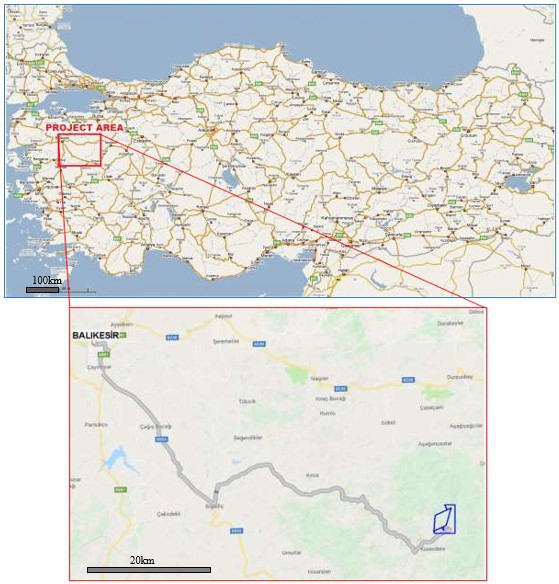
Figure from OreWin, 2019
Figure 5-1: Project Location Map
The Project is accessed along 102 km of paved road from the city of Balıkesir (population 1,189,075) on highway D555 through the town of Bigadiç (population 48,470). The road from Bigadiç to the Project site was widened and paved to be suitable for light and heavy vehicles (Figure 5-2). The road currently serves lumber trucks, concrete trucks, buses, and light vehicles. A 3.1 km by-pass road was constructed in 2017 to divert around the local Hacıömerderesi neighborhood (Figure 5-3).
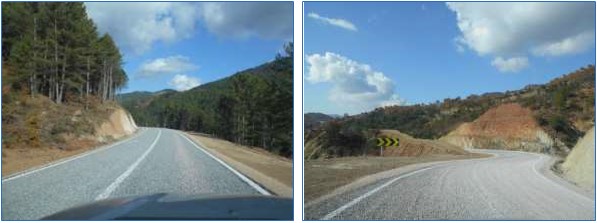
Figure from OreWin, 2019
Figure 5-2: Paved Road
The nearest airport, Balıkesir Koca Seyit Airport serving Balıkesir and Edremit, is approximately 185 km by road from site. There are also airline services to the nearest major city of Izmir, which is approximately 242 km by road via Bigadiç.
The Project site is centrally located to access several ports by road (distances are approximate from site via Bigadiç):
- Bandırma port is 194 km to the north,
- Dikili port is 207 km to the west,
- Aliağa port is 224 km to the west, and
- Izmir port is 242 km to the southwest
The nearest railway stations are in Dursunbey to the north and Balıkesir to the northwest.
The Project land position consists of a single operating license number (OL) RN85535, with a total area of 1,486.99 ha, of which 76% is forest area (Figure 5-3).
The region covering the Project area is classified as "1st Degree Earthquake Zone" according to the Seismic Zone Map of Turkey.
There are nearby population centers to the Project to supply manpower, and adequate access to support mining operations at Gediktepe,
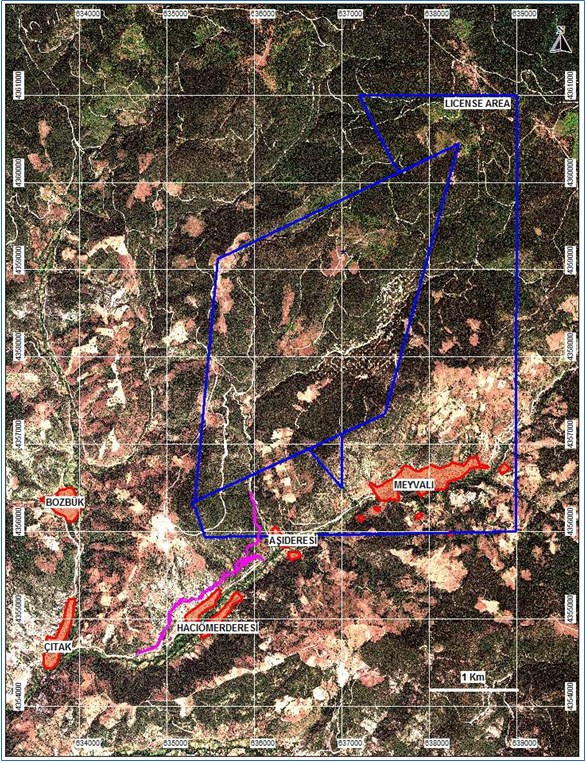
Figure from OreWin, 2019
Figure 5-3: Gediktepe Project Area and By-pass Road. Pink color shows the by-pass road, constructed in 2017
5.2 Physiography
The terrain at the Project is mountainous with steep erosional valleys. Elevations in the Project area range from 974-1,482 m above sea level (masl). Coniferous trees cover most of the Project site, with occasional open meadows in areas of less-steep terrain. Figure 5-5 is a topographic map of the area.
5.3 Climate
Three climates are dominant in Balıkesir Province. The Mediterranean climate is seen in the Aegean coasts, the Marmara climate in the north, and the Continental climate in the inner regions. The temperature difference between summer and winter is small on the coastline. This difference is bigger in the interior of the province. In the mountainous eastern region, winters are harsh, and summers are cool.
The local climate is hot and arid during the summer and warm during the fall. There is snow from December through February but not a significant accumulation. Spring is often the rainy period. According to data from Dursunbey Meteorological Station for the years 1965-2014, the annual average temperature is 12.2°C. The highest measured temperature was recorded as 40.3°C in 2007 and the lowest temperature was recorded as -16°C in 1985.
The wind generally blows from the north or northeast.
Average evaporation from the Dursunbey Meteorological Station data is 943 mm per year with the highest average monthly evaporation of 190 mm experienced during July.
A meteorological station was installed at site at the end of 2014 as part of the environmental base line data collection.
Given Gediktepe's physiographic and climatic conditions DAMA has no reason to believe that year-round operations of the Project are not possible.
5.4 Local Resources
The closest settlements to the Project site are:
- Hacıömerderesi neighborhood,
- Aşıderesi neighborhood, affiliated with the Hacıömerderesi neighborhood, and
- Meyvalı neighborhood.
The main economic income sources in the area are forestry, agriculture, and animal husbandry.
The local area is serviced by a family doctor, who visits the neighborhoods once per month, accompanied by a nurse and a midwife when necessary. The closest hospital is the Bigadiç State Hospital, and there is a university hospital in Balıkesir Province.
A field camp was constructed at Kürendere, approximately 7 km (air distance) southwest of the Project area and is currently partially in use. The field camp includes accommodation, kitchen, and social facilities (Figure 5-4).
There is an open pit borax mine in Bidagiç, operated by the State Enterprise, and an open pit gold mine in Sındırgı. Regionally, gold, silver, lead, copper, zinc, molybdenum, and chromite mines have operated for many years. The regional authorities and residents are familiar with co-existing mining operations.
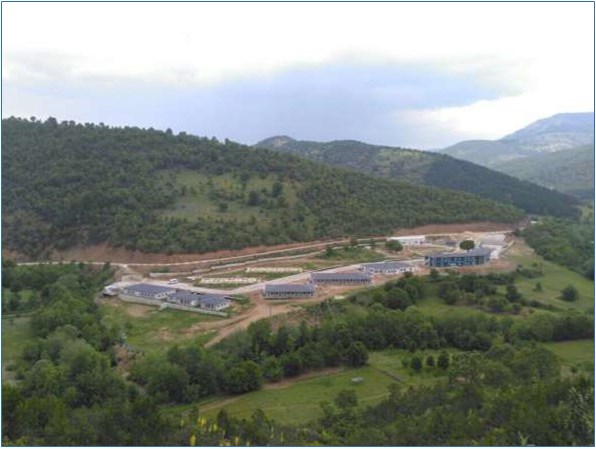
Figure from OreWin, 2019
Figure 5-4: Aerial Photograph of Gediktepe Field Camp
5.5 Infrastructure
As of the effective date of the historical PFS19 and TR20 reports, a water supply needed to be established for the Project as there was no developed system in the area capable of supporting a project of Gediktepe's size. For that reason, a clean water pond with 682,497 m3 active reservoir capacity was engineered after signing the Protocol with DSI (State Water Works) and a village water supply pipeline was designed and approved by the Balıkesir Water Sewage Authority (BASKI). As per Environmental Impact Assessment (EIA) commitments, a water supply pipeline will be constructed before any site work will start (Figure 5-5).
A 39.6 km-long 34.5 kV power transmission line (PTL) was constructed between Dursunbey substation and Kürendere to provide power to the Project.
The historical PFS19 and TR20 reports outlined tailings storage areas, heap leach pad areas, and processing sites within the Project Operating License.
With accessible power and access to areas for infrastructure for the Project, the principal contingency requiring final resolution to support mining operations at Gediktepe is securing an adequate water supply. See Section 12 for updates based upon 2021 site visits.
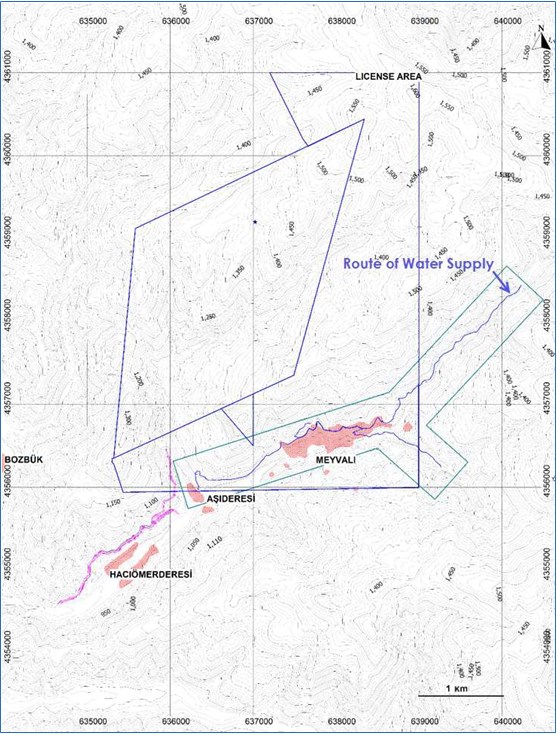
Figure from OreWin, 2019
Figure 5-5: Gediktepe Topography and Water Supply Route. Contoured at 10 m intervals
6. History
6.1 Prior Ownership and Ownership Changes
The Gediktepe mining licenses are held by Polimetal Mining Industry and Trade Inc., otherwise known as Polimetal Madencilik San. ve Tic. A.Ş. ("Polimetal"), which was formed in 2011 as a joint venture (JV) company between Lidya Madencilik San. ve Tic. A.Ş. ("Lidya") (50%) and Alacer Gold Corp. ("Alacer") (50%). The Gediktepe deposit was discovered in 2012-2013 by the JV.
Alacer sold its 50% non-operating ownership interest in the Project to Lidya in 2019, with Alacer retaining a) a 10% NSR royalty on all oxide ore production, and b) a 2% NSR on all sulfide ore production. The sale to Lidya resulted in Lidya consolidating 100% control of the Gediktepe Project. Subsequently, Alacer and SSR Mining Inc. completed a merger transaction in 2020, whereby Alacer became a wholly owned subsidiary (along with the Gediktepe royalties) of SSR Mining.
6.2 Licenses and Permits
Alacer obtained the first exploration license for the Gediktepe Project in 2005. That license, number 20054077, constituted the central area of the Project. Also refer to Section 4.1 of this Technical Report.
Alacer completed geochemical stream sampling prior to June 23, 2011, at which time the license was transferred to Polimetal (now wholly owned by Lidya), the current operator.
Permit applications have been submitted at various times for site activities necessary to support technical investigations leading to the ultimate approval of a mining and mineral processing project.
Permit activity related to this license has included:
An EIA Permit was obtained on August 22, 2012 for Phase 1 drilling that included 21 drill locations. The forestry permit for 11 drill locations was obtained on March 17, 2013. An EIA permit to undertake drilling at 234 locations was obtained on March 14, 2012 and June 18, 2013 and a forestry permit was obtained on October 11, 2013.
For Phase 2 drilling, an EIA permit to undertake drilling at 139 locations was obtained on December 18, 2013 and February 4, 2014 and a forestry permit was obtained on September 2, 2014.
For Phase 3 drilling, an EIA Permit to undertake drilling at 264 locations was obtained on April 2, 2014 and a forestry permit was obtained on September 2, 2014.
In mid-2014, Polimetal (Lidya) commissioned a Preliminary Economic Assessment (PEA) of the Project to determine its economic potential. The PEA identified a combined oxide and sulfide Indicated Mineral Resource of approximately 10 Mt. Oxide processing was by heap leaching, while the subsequent sulfide processing was through a concentrator.
Based on the PEA findings, Polimetal (Lidya) continued site investigations, including additional drilling aimed at increasing the size of the Mineral Resource.
A Phase 4 Drilling EIA permit was obtained on June 27, 2014 for 344 drill locations, 175 of which received subsequent forestry approval.
For the meteorological station, an EIA permit was obtained on February 3, 2014 and a forestry permit was obtained on September 2, 2014.
Based on a PEA, a revised project operation was submitted to the General Directorate of Mining and Petroleum Affairs (GDMPA) on September 25, 2014 to enlarge the operation permit area and to change the annual production and processing capacity to as much as 2,375 kt of run of mine-ore.
An EIA Permit was obtained to undertake 242 drill and trench locations on June 27, 2014. The forestry permits for 17 drill and trench locations were received on November 13, 2015. Forestry permit approval of another 61 drill and trench locations planned for Stage 2 geotechnical investigations followed.
An EIA application for oxide and sulfide mining and processing was submitted on July 9, 2015 and a public participation meeting was held on August 11, 2015. The EIA report was submitted to the Ministry of Environment and Urbanisation on December 15, 2015 and received a positive certificate on July 1, 2016.
Forestry permits for drilling locations within the EIA boundary were received on May 15, 2017 & December 16, 2019, respectively.
On July 17, 2019, Alacer announced at the Toronto Stock Exchange the sale of its 50% non-operating interest in the Gediktepe Project to its joint venture partner Lidya. The process of the share transfers was completed at the General Directorate of Mining and Petroleum Affairs (MAPEG). Lidya now owns 100% of Polimetal and the Gediktepe Project.
On July 19, 2019, Polimetal applied for a 169-hectare (ha) forest permit area.
6.3 Historical Reports
This section summarizes sections from PFS19 and also references material from PFS16 and TR20 as appropriate and as noted. Information concerning sulfide processing as well as oxide processes have been sourced from PFS19. TR20 covers more recent information concerning oxide processing plans.
6.3.1 Historical Exploration and Drilling
There were five phases of core (DD) and reverse circulation (RC) exploration drilling at Gediktepe, commencing in 2013 and ending in 2018. This resulted in 438 DD holes totaling 56,898 meters and 191 RC holes totaling 13,229 meters.
Exploration drilling (Phase 1) commenced in April 2013. Throughout the phases drilling was completed by local contractors. Diamond drill holes were predominantly started using PQ core size, and rarely with HQ. Most deeper holes, however, needed to switch to HQ at depth.
Eight of the initial 11 Phase 1 holes were angled holes, with the remainder of the holes vertical or sub-vertical. The average deviation of the surveyed holes is less than 1° per 100 m. The count of drillholes used in the PFS19 dataset from Phase 1 was 11 drillholes totaling 1,529 meters.
RC drilling was restricted to Phases 2 and 3 and was conducted on the margins of the deposit to define extensions or set limits, and for infill. The count of drillholes used in the PFS19 was 228 drillholes totaling 24,078 meters from Phase 2, and 260 drillholes totaling 32,853 meters from Phase 3.
A drilling EIA permit was obtained for Phase 4 in June 2014 for 344 drill locations, 175 of which received subsequent forestry approval. The total amount of drillholes used in the PFS19 dataset from Phase 4 was 93 DD totaling 5,252 meters. Phase 5 drilling included 36 drillholes totaling 6,414 meters.
At the end of each phase of drilling, drillhole collars were surveyed by a local surveying firm. RC drillholes were not downhole surveyed.
During 2015, Polimetal and Alacer commissioned a prefeasibility study (PFS16) on the Project. This study used all drilling performed up to August 2015. PFS16, which was filed on SEDAR in June 2016, identified a significant combined oxide and sulfide Measured plus Indicated Mineral Resource and based on favorable technical and economic factors, identified a combined oxide and sulfide Mineral Reserve and a potential mining and processing operation with a 12-year mine-life. The PFS16 technical report was superseded by the 2019 Prefeasibility Study.
Of the total drillhole database, a subset of drilling comprised of 624 DD and RC holes totaling 68,968 m of drilling was used for geological modelling and resource estimation work in the PFS19 report by OreWin. Of the 438 diamond drillholes in the PFS19 Drillhole Dataset, 388 have downhole survey data.
Table 6.1 summarizes the PFS19 Drillhole Dataset and Figure 6-1 shows the drillhole dataset locations in plan view.
The cut-off date for the PFS19 Drillhole Dataset was March 21, 2018.
Table 6.1: Summary of PFS19 Drillhole Dataset to March 21, 2018
| Drilling Phase | Period | Diamond
Drilling | Reverse
Circulation
Drilling |
No.
of
Holes | Meters
Drilled | No.
of
Holes | Meters
Drilled |
| 1 | 2013 | 11 | 1,529 | - | - |
| 2 | 2013/2014 | 144 | 17,158 | 84 | 6,920 |
| 3 | 2014/2015 | 153 | 26,544 | 107 | 6,309 |
| 4 | 2017 | 93 | 5,252 | - | - |
| 5 | 2017/2018 | 36 | 6,414 | - | - |
| Total | 438 | 56,898 | 191 | 13,229 |
Table from OreWin, 2019
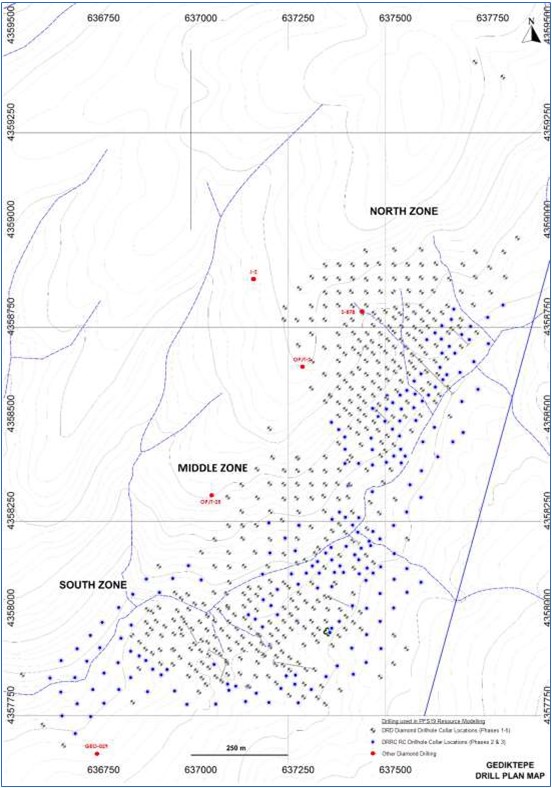
Figure from OreWin,2018
Figure 6-1: Historical Drillhole Location Plan - PFS19 Drillhole Dataset
6.3.2 Historical Mineral Processing and Metallurgical Testing
Details of metallurgical test work completed between 2015-2019 for both the oxide and sulfide zones of the Gediktepe deposit are reviewed and summarized in this section. The test work was generally carried out to support PFS16 and PFS19. The investigation largely focused on cyanidation of oxidized material tests for gold and silver recovery, and sulfide ore tests to recover marketable copper and zinc concentrates by sequential flotation methods. DAMA notes that one of the significant differences between the two pre-feasibility studies is the change in the treatment of oxide material from the crush-agglomerate-heap leach-zinc precipitation flowsheet proposed in the PFS16 to crush-grind-leach-CIP-elution flowsheet in PFS19. In TR20, Polimetal (Lidya) selected the crush-agglomerate-heap leach-zinc precipitation flowsheet outlined in PSF16, but with two-stage crushing as opposed to three-stage crushing as the operable choice.
From the TR20 report, Lidya focused on optimizing the processing of the oxide zone material using cyanidation for the recovery of gold and silver from heap leaching, Merrill Crowe, and tank leaching. Considering the initial capital expenditures, operational expenditures and long delivery time of a SAG mill, the treatment of oxide material was selected as the crush- agglomerate-heap leach-zinc precipitation flowsheet with the only difference being two-stage crushing proposed in TR20 as opposed to the three-stage crushing proposed in PFS16. The results of the additional TR20 oxide test work suggests potential improvements to the PFS19 recoveries of 80% for gold and 45% for silver on the order of +- 5%.
The oxide processing facility was designed to treat 0.72 Mtpa of ore for three years at full capacity and 0.51 Mtpa in yar four.
Regarding sulfide processing, the PFS19 identified performance variations between 2016-2018 sulfide test works due to the following reasons.
- Surface oxidation (aging effect),
- Mineralogical and head grade variations,
- Material type blends, and
- Pulp chemistry conditions.
To assess the metallurgical performance of the sulfide flotation flowsheet, the results of locked cycle tests (LCT) were used with additional batch roughing and cleaning tests.
6.3.3 Historical Block Model Resource Estimation Methods
The block model was built on the basis of a parent cell dimension of 20 m (E) x 20 m (N) x 10 m (RL) and constructed with coding applied to represent volumes of geological units, and mineralization and weathering domains. The sample dataset was coded in a corresponding fashion and evaluated statistically and geostatistically. The major grades of economic interest to the Project, namely Au, Ag, Cu, and Zn, were estimated into the mineralization domains and background material portions of the block model. The minor grades Pb, As, C, Pb, S, Fe, and Hg, along with bulk densities, were similarly estimated into both mineralization and background domains. Figure 6-2 shows the mineralization domain interpretations.
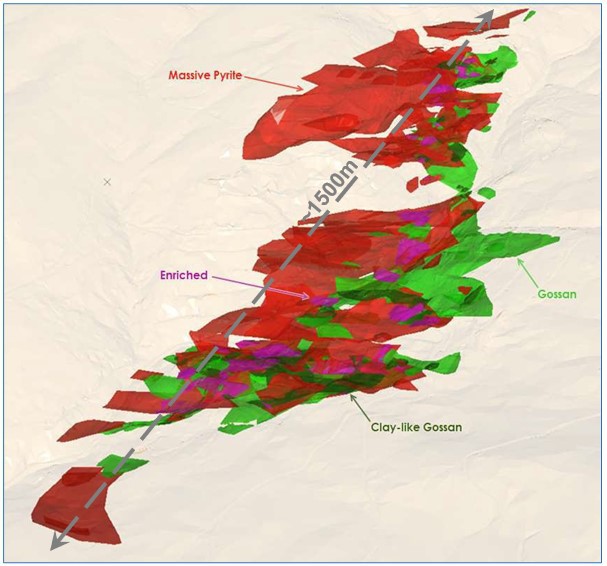
Figure from OreWin, 2019
Figure 6-2: Historical PFS19 Oblique View of Mineralization Solid Interpretations
Grades were estimated using either ordinary kriging (OK) or inverse distance weighting to the power of two (ID2). Depending on the domain being estimated, composites of either 1 m or 2 m (notional) length were used. Following grade estimation, any cells coded as being within a mineralized domain that failed to receive an estimate were assigned default values using the same values as those used for unsampled sample intervals. Global and zonal statistics were generated to confirm that estimated model grades values fell within acceptable limits.
The modelled estimates were assessed for levels of geological confidence, and accordingly classified into Measured, Indicated, and Inferred categories, referencing CIM guidelines (CIM, 2014). The Mineral Resource tonnages and grades have been reported using NSR cut-offs and constrained within an optimized pit.
6.3.4 Historical Mineral Resources
The PFS19 historical resource is reported using cut-offs based on calculations of NSR. This method is considered to be appropriate for polymetallic deposits such as Gediktepe. Separate NSR cut-offs are applied to each of the oxide and sulfide zones.
CIM guidelines required that a Mineral Resource must have: "reasonable prospects of economic extraction". To meet this requirement, the classified resource has been constrained to those model blocks falling within an optimized pit shell that was developed using the metal price parameters used for the determination of Mineral Reserves but increased by 14%, and where all categories of material (including Inferred) have been considered in the pit optimization. Mineral Resources that are not Mineral Reserves do not have demonstrated economic viability.
Table 6.2 shows "Historical Estimates" within the meaning of NI 43-101. The source of the estimates is Section 14 of PFS19. The historical estimates set forth in Table 6.2 do not use categories of mineral resources other than the ones set out in the CIM Definition Standards and Section 1.2 of NI 43-101.
A qualified person has not performed sufficient work to classify the PFS19 historical resource estimates as current mineral resources, and DAMA is not treating the historical estimates as current. Significant data compilation, confirmation drilling, re-sampling and data verification may be required by a qualified person before the historical estimates can be classified as current mineral resources. The historical PFS19 resource estimates are considered to be relevant and are presented for the purpose of describing the extent and nature of mineralization as presently understood. The historical PFS19 resource estimates should not be relied upon until verified by a qualified person.
Table 6.2: Historical Gediktepe PFS19 Mineral Resources - All Classifications
| MEASURED | Tonnes
(kt) | Grade | Metal |
Au
(g/t) | Ag
(g/t) | Cu
(%) | Zn
(%) | Pb
(%) | Au
(koz) | Ag
(koz) | Cu
(kt) | Zn
(kt) |
| Oxide | Gossan | - | - | - | - | - | - | - | - | - | - |
| Low Oxide | - | - | - | - | - | - | - | - | - | - |
| Total Oxide | - | - | - | - | - | - | - | - | - | - |
| Sulfide | Massive Pyrite | 3,999 | 0.67 | 25.1 | 1.01 | 1.83 | 0.34 | 86 | 3,221 | 40 | 73 |
| Diss. Sulfide | - | - | - | - | - | - | - | - | - | - |
| Enriched | - | - | - | - | - | - | - | - | - | - |
| Total Sulfide | 3,999 | 0.67 | 25.1 | 1.01 | 1.83 | 0.34 | 86 | 3,221 | 40 | 73 |
| Total Measured | 3,999 | 0.67 | 25.1 | 1.01 | 1.83 | 0.34 | 86 | 3,221 | 40 | 73 |
| INDICATED | Tonnes
(kt) | Grade | Metal |
Au
(g/t) | Ag
(g/t) | Cu
(%) | Zn
(%) | Pb
(%) | Au
(koz) | Ag
(koz) | Cu
(kt) | Zn
(kt) |
| Oxide | Gossan | 2,562 | 2.79 | 67.6 | 0.1 | 0.1 | 0.48 | 230 | 5,571 | 3 | 2 |
| Low Oxide | 112 | 0.83 | 36.9 | 0.22 | 0.18 | 0.21 | 3 | 132 | 0 | 0 |
| Total Oxide | 2,674 | 2.71 | 66.3 | 0.1 | 0.1 | 0.47 | 233 | 5,703 | 3 | 3 |
| Sulfide | Massive Pyrite | 17,049 | 0.83 | 30.4 | 0.87 | 1.92 | 0.38 | 454 | 16,681 | 148 | 327 |
| Diss. Sulfide | 5,588 | 0.4 | 15.9 | 0.43 | 0.87 | 0.18 | 71 | 2,853 | 24 | 48 |
| Enriched | 907 | 1.19 | 45.7 | 3.14 | 2.61 | 0.22 | 35 | 1,331 | 28 | 24 |
| Total Sulfide | 23,544 | 0.74 | 27.6 | 0.85 | 1.69 | 0.33 | 560 | 20,865 | 200 | 399 |
| Total Indicated | 26,217 | 0.94 | 31.5 | 0.78 | 1.53 | 0.34 | 792 | 26,568 | 203 | 402 |
| | | | | | | | | | | | |
| INFERRED | Tonnes
(kt) | Grade | Metal |
Au
(g/t) | Ag
(g/t) | Cu
(%) | Zn
(%) | Pb
(%) | Au
(koz) | Ag
(koz) | Cu
(kt) | Zn
(kt) |
| Oxide | Gossan | 12 | 1.09 | 22.4 | 0.08 | 0.08 | 0.15 | 0 | 9 | 0 | 0 |
| Low Oxide | 11 | 0.78 | 21 | 0.4 | 0.21 | 0.09 | 0 | 7 | 0 | 0 |
| Total Oxide | 23 | 0.95 | 21.8 | 0.23 | 0.14 | 0.12 | 1 | 16 | 0 | 0 |
| Sulfide | Massive Pyrite | 2,847 | 0.52 | 20 | 0.77 | 1.15 | 0.27 | 47 | 1,832 | 22 | 33 |
| Diss. Sulfide | 111 | 1.01 | 26.3 | 0.43 | 1.39 | 0.26 | 4 | 94 | 0 | 2 |
| Enriched | - | - | - | - | - | - | - | - | - | - |
| Total Sulfide | 2,958 | 0.53 | 20.2 | 0.76 | 1.16 | 0.27 | 51 | 1,926 | 22 | 34 |
| Total Inferred | 2,981 | 0.54 | 20.3 | 0.76 | 1.16 | 0.27 | 51 | 1,941 | 23 | 34 |
Table from OreWin, 2019
Notes (reference to Mineral Resources is used in the context as Historical Mineral Resources):
1 CIM definitions were followed for the Mineral Resources.
2 Effective Date of the Mineral Resources is March 5, 2019.
3 Mineral Resources were estimated within geologic domains by either ordinary kriging or inverse distance.
4 Mineral Resources are reported at NSR cut-offs of $20.72/t for oxide and $17.79/t for sulfide using the mineral reserve metal prices x 1.14 (+14%) and variable metal recoveries according to material and mineralization type (refer to Table 6.3 of this Technical Report and the PFS19 report for details).
5 Mineral Resources have been constrained using an optimized pit shell, to reflect reasonable prospects of economic extraction.
6 Mineral Resources that are not Mineral Reserves do not have demonstrated economic viability.
7 Mineral Resources are inclusive of Mineral Reserves, except for mining losses and grade dilution, which are determined through re-blocking of the resource model after declaration of the Mineral Resource.
8 Mineral Resources are quoted on a 100% project basis.
9 Totals may not match due to rounding.
6.3.5 Historical Mineral Reserves
The historical PFS19 Gediktepe Mineral Reserves, reported according to the CIM guidelines, are shown in Table 6.3. Due to its polymetallic nature, the oxide and sulfide portions of the historical Mineral Reserves are quoted at different NSR cut-offs based on metal prices, metal recoveries, plus on and off-site processing costs.
Table 6.3 shows "Historical Estimates" within the meaning of NI 43-101. The source of the estimates is Section 15 of PFS19. The historical estimates set forth in Table 6.3 do not use categories of mineral reserves other than the ones set out in the CIM Definition Standards and Section 1.3 of NI 43-101. For further details on the parameters utilized in the estimates, the reader is referred to Section 15 of the PFS19 report.
A qualified person has not performed sufficient work to classify the historical PFS19 reserve estimates as current mineral reserves, and EMX is not treating the historical estimates as current mineral reserves. Significant data compilation, confirmation drilling, re-sampling, data verification and updating of metal prices, engineering assumptions, and economic parameters may be required by a qualified person before the historical PFS19 estimates can be classified as current. The historical PFS19 reserve estimates are considered to be relevant and are presented for informational purposes to describe the extent and nature of mineralization on the Project as presently understood. The historical PFS19 reserve estimates should not be relied upon until verified by a qualified person.
Table 6.3: Historical Gediktepe PFS19 Mineral Reserves
| Classification | Tonnes (kt) | Grade | Contained Metal |
Au
(g/t) | Ag
(g/t) | Cu
(%) | Zn
(%) | Au
(koz) | Ag
(koz) | Cu
(kt) | Zn
(kt) |
| Oxide |
| Proven | - | - | - | - | - | - | - | - | - |
| Probable | 2,755 | 2.34 | 56.7 | - | - | 207 | 5,020 | - | - |
| Proven & Probable | 2,755 | 2.34 | 56.7 | - | - | 207 | 5,020 | - | - |
| Sulfide |
| Proven | 3,620 | 0.68 | 26.7 | 1.03 | 1.93 | 79 | 3,105 | 37 | 70 |
| Probable | 14,960 | 0.89 | 33.1 | 0.89 | 1.99 | 429 | 15,903 | 133 | 298 |
| Proven & Probable | 18,580 | 0.85 | 31.8 | 0.92 | 1.98 | 509 | 19,008 | 170 | 368 |
Table from OreWin, 2019
Notes (reference to Mineral Reserves is used in the context as Historical Mineral Reserves):
1 CIM definitions were followed for the Mineral Reserves.
2 Effective Date of the Mineral Reserve is March 5, 2019.
3 Mineral Reserves were reported using a NSR based on metal prices of $1,300/oz Au, $18.5/oz Ag, $3.30/lb Cu, and $1.28/lb Zn, smelter terms for treatment and refining charges and transport including ocean freight for sulfide concentrates.
4 Cut-offs applied were: oxide $20.67/t and sulfide $17.74/t. Additionally, enriched mineralization with a Cu/Zn grade ratio < 0.75 is considered to be waste.
5 Reported Mineral Reserves incorporate and include mining losses and grade dilution that are not reported in the Mineral Resource.
6 Only Measured Mineral Resources (and dilution) were used to report Proven Mineral Reserves and only Indicated Mineral Resources (and dilution) were used to report Probable Mineral Reserves.
7 Mineral Reserves are a subset of, not additive to, the Mineral Resources and are quoted on a 100% project basis.
8 Totals may not match due to rounding.
6.3.6 Historical Mining Methods
AMC was contracted by Polimetal (Lidya) to conduct open pit mine design and Mineral Reserve estimation for the PFS19 study. The study was reviewed and verified by OreWin and integrated into the PFS19 report, effective March 26, 2019. In October 2019, by request of Polimetal (Lidya), another mining study was conducted by AMC for the oxide zone of the resource; this study is included in TR20.
As of the effective date of this Technical Report, the initial open pit operation has commenced within the oxide zone, but commercial production has not yet been achieved. After finishing the oxide zone, the sulfide zone of the reserve will be mined. Open pit mining will be carried out by conventional diesel-powered truck and excavator, and small mining equipment (3-4 m3-excavator) will be used for selective mining. An experienced mining contractor will be employed for both waste removal and ore mining. The mining activities will be supervised by Lidya's team. The oxide zone operation will be performed on benches of 5 m considering ore control block dimension & slope. The operation bench height might have to change to 2.5 m as sulfides start to require more selective mining to decrease dilution.
Grade control will be performed under the supervision of the mine geologists. Blastholes are to be regularly sampled for laboratory assay analysis. Feed to the process plants is expected to be a combination of both direct tipping and reclaim from ROM stockpiles to ensure optimal feed to the crushing plant as 90% gossan & 10% clay like oxide as an ore blend.
6.3.6.1 General Overview of Historical Production Schedules
No mining study or production scheduling was performed by DAMA. The historical production schedules were presented in PFS19 and TR20.
As detailed in the PFS19 report, AMC conducted a mining study which incorporated a production schedule for oxide and sulfide material by phasing open pits. This study was checked by OreWin and included in PFS19. Later, Polimetal (Lidya) decided to change the oxide processing method and contract with AMC again to conduct a mining study for only oxide ore of the resource. In TR20, it was reported that the oxide reserve remained unchanged from the PFS19 report. The PFS19 mine schedule for sulfide material was not updated in TR20.
The key criteria used for achieving production tonnages per year were:
720 ktpa throughput for the oxide plant (TR20), and
2,378 ktpa throughput for the sulfide concentrator (PFS19).
The Whittle optimized dynamic ore cut-offs are established based on the calculated NSR, and operating costs associated with each mining model cell to determine which volumes (tonnages) generate revenue.
An oxide production schedule was reviewed from TR20 which includes the three individual pits as stages. It is reported that the schedule was developed using Minemax strategic scheduling software. The following parameters were used for scheduling:
Scheduled in quarters.
Maximum vertical advance rate 5 by 5m benches per quarter.
Maximum waste movement each quarter of 820kt.
Mill feed of 180 kt per quarter with no build up.
The sulfide production schedule comes from PFS19. During the period when both oxide and sulfide ore are available for treatment, parcels of ore will be campaign treated. This will coincide with the ramp-up period for the sulfide ore and will allow development of operating knowledge for the treatment of the sulfides allowing time to analyze data during the oxide campaigns.
The mine will commence waste rock removal during the preproduction period of Year -1, waste rock stripping was scheduled to excavate 2.11 Mt of material. As loading equipment and haul trucks come online, waste rock removal and low-grade mineralized material stockpiling rates will increase until the earthwork requirements are met and the mill is ready for production. In the preproduction period, 200 kt mineralized material will be stockpiled.
The processing schedules for both oxide and sulfide ores incorporate ramp-up rates with a monthly resolution. In addition to throughput, metal recovery factors for oxide and sulfide are also ramped up to design over a 3 to 9-month period. An important aim of the mining and processing scheduling is to minimize sulfide ore residence time on stockpiles due to the expected recovery reduction associated with ore oxidation after mining.
It is reported that to manage metal recovery and the proportion and characteristics of the complex copper concentrate, inclusion of the higher-grade enriched mineralization was capped at 10% of the sulfide tonnage processed within any schedule period. After metallurgical review of the initial scheduling results, the enriched controls were expanded to exclude any enriched mineralization with a Cu/Zn ratio of < 0.75 (approximately 20% of the available enriched tonnage), from processing. It is noted by DAMA that enriched material with a Cu/Zn ratio of < 0.75 is excluded from the historical Mineral Reserves.
6.3.7 Historical Recovery Methods
The metallurgical test work programs demonstrated that oxide and sulfide types of material require different treatment methods for the Gediktepe deposit, as would be expected.
From TR20, the oxide processing facility has been designed to treat 0.720 Mtpa of oxide ore for three years at full capacity and 0.510 Mt in year 4. The project will be installed and commissioned as:
Oxide ore production - comprising approx. three & half year period for processing gold and silver ore, which will be crushed down to - 19 mm (P100) in two-stage crushing & agglomeration, followed by sodium cyanide heap leaching with zinc precipitation in a Merrill Crowe plant, and
Considering higher capital & operating costs for tank leaching processing and having been able to identify suitable new heap leach pad areas within the mining license, it was decided to start Gediktepe oxide processing with the PFS16 flowsheet, with the only difference being two-stage crushing rather than three stage crushing.
The major unit operations of the oxide process flowsheet have been tested at bench scale, along with specialist vendor test work as required.
The sulfide sample test results showed that saleable flotation concentrate products can be produced from conventional comminution and flotation processes. For sulfide ore production a separate standalone sulfide feasibility study will be completed in the first year of oxide production. As of the effective date of this Technical Report, the PFS19 sulfide processing flowsheet is considered to be most representative, albeit subject to change based upon further studies to be documented in Lidya's pending Gediktepe Feasibility Study.
The TR20 oxide flowsheet is presented in Figure 6-3 and the PFS19 flowsheet for sulfide in Figure 6-4.
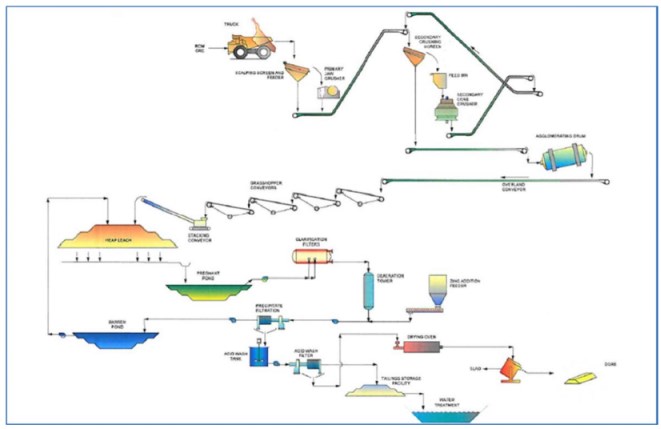
Figure from TR20
Figure 6-3: Historical TR20 Flowsheet for Oxide Processing
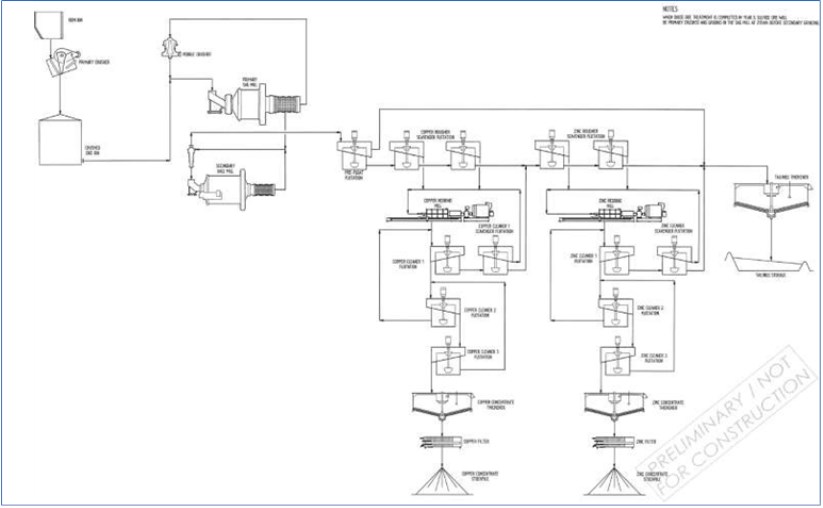
Figure from OreWin, 2019; after GRES, 2019
Figure 6-4: Historical PFS19 Flowsheet for Sulfide Processing
6.3.8 Historical Site Infrastructure
This section was taken from TR20 as well as from observations made during the DAMA and EMX site visits (refer to Section 12).
The Project requires the development of several infrastructure items in order to operate. This includes the following items:
- Heap Leach Pad (HLP): Construction continues on the heap leach facility design.
- Waste Storage Facility (WSF): Construction continues on the waste storage facility design.
- Water Supply: A water supply system is required for the Project. Two underground water wells have already been drilled, cased and permitted. However, for backup water, two more holes, that were already drilled and cased, need to be permitted.
- Power Supply: A new power supply system has been constructed by Polimetal for the site.
- Access Road: An access road that bypasses the local village of Haciomerderesi has been constructed.
- Mine Site Buildings: A small mine camp has been constructed close to the Project site to house Polimetal staff. However, it is planned to locate mine workers in Bigadic or in Balıkesir. Additional project technical and administrative buildings are under construction.
- Water Diversion Channels: Water diversion channels at the Mine Site for capturing and diverting both contact and non-contact water have been constructed.
Additional infrastructure will be constructed for the sulfide mining stages of Project development that include the following:
- Tailing Storage Facility (TSF): Will be designed and sized to contain approximately 18.5 Mt of mined sulfide material and be constructed in the third year of operation of oxide ore to prepare the area for sulfide ore.
- The ROM Pad.
- The ROM Stockpile Area.
- Copper Concentrate Storage Area.
- Zinc Concentrate Storage Area.
6.3.9 Historical Environmental Studies, Permitting and Social or Community Impact
Environmental baseline studies include: baseline water quality, acid rock drainage, flora and fauna studies, and an EIA. The EIA was compiled and submitted to the Ministry of Environment and Urbanization in 2015, however it was revised in 2016 and again in 2019. Another EIA report will be compiled and submitted when the Project design is finalized at the end of the Project feasibility studies.
Permits required for the Project include the EIA update, forest permits, explosive usage and storage permits, environmental permits, explosive transport permit, highway connection permit, village road use permit, water and underground water usage permits, private security permit, radio permit, permit for non-agricultural use, and a temporary storage permit for hazardous waste. DAMA notes that construction and initial oxide mining has commenced, suggesting that Polimetal has the required permits in place.
Approximately 90.8% of the Project area belongs to the State Forest Department and the remaining land is owned privately by the Municipality, Treasury, and individuals (1,068,313.4 m2). To date, 756,265 m2 of private lands have been purchased by Polimetal (Lidya), and the purchasing process continues.
The Project has had the support of the local community since 2012. There are no protection areas near the Project area.
Details of Project closure are being finalized and require additional information for design. The collection of that information is in progress or is incorporated into the project execution plan for future action.
6.3.9.1 Historical Other Relevant Data and Information
6.3.9.2 Pre-Feasibility Study and Gediktepe Project Oxide Technical Report
The historical PFS19 report is at a pre-feasibility level of accuracy. It identified a positive business case and recommended that the assessment of the Project be continued to a feasibility study level in order to increase the confidence of the estimates. There are a number of areas that needed to be further examined and studied and arrangements that need to be put in place to advance the development of the Project.
TR20 covers some of these areas and identifies additional work to be completed that is specifically focused on near term oxide production. The project execution plan was developed by Polimetal (Lidya) in order to outline the main tasks that will be required prior to commencement of production.
The project execution plan is focused on the engineering to ore processing phases, with an emphasis on expediting oxide ore mining and processing. The seven components that were to be addressed prior to oxide production include:
1) Forest Permitting.
2) Tree Clearance.
3) Heap Leach Facility (Phase 1) completion.
4) Oxide Plant Construction and Processing.
5) Construction of Other Project Infrastructure.
6) Mining Pre-Production and Production.
7) Heap Leach Facility (Phase 2) completed once initial production is in progress.
See Section 12 for more recent observations from DAMA's site visits concerning construction of the oxide mining phase of the Project.
6.3.9.3 Historical Mineral Resources Recommendations
The historical PFS19 report suggests the resource classification categories assigned to the Project estimates (Measured, Indicated, and Inferred) have, at a global scale, identified different levels of confidence (uncertainty) across the deposit, and this is considered sufficient for prefeasibility assessment. It was recommended that additional work be undertaken in an effort to reduce this uncertainty. This may involve:
- Additional, focused drilling.
- A short-range variability study to attempt to better understand the grade distributions.
- Selected resampling and assaying.
- Review of local geological and mineralogical interpretations.
- Refinement of resource modelling and grade estimation procedures.
After further internal studies according to TR20, the resource classification categories assigned to the Gediktepe estimate is considered sufficient for oxide ore production.
6.3.9.4 Historical Mining Method Recommendations
The historical PFS19 report recommended the following mining method work to be carried out for the feasibility study:
Update and revise the open pit and waste dump designs based on updated process parameters from additional test work recommendations.
Prepare detailed designs and schedules for the waste dumps, including the PAG dump. Detailed specifications for the PAG dump should be prepared for the dump design, management, and closure.
Investigate the possibility of encapsulating the PAG within cells in the main waste dump.
Obtain updated mining contractor budget pricing based on the final feasibility study mine plan and schedules.
TR20 suggests that ore production will require blending of the clay like oxide ore with gossan oxide ore at the average rate of 12% and that careful management of the stockpiles will be required. This necessitates a coordinated approach to the management and operation of the ore feed from the mine to the crusher. PAG and non-PAG waste will be stored in different dedicated areas.
A detailed plan in regard to grade control measures during mining is required. To arrive at the most appropriate grade control strategy, studies into the accuracy and practicality of the various available measures should be undertaken, including, but not limited to, blasthole sampling, RC drillhole sampling, trenching, grab sampling, and portable XRF sampling, as well as methods for obtaining accurate and meaningful mapping data from already-mined benches. The feedback of this information into the grade control model in a timely and accurate way will be very important.
6.3.9.5 Historical Process and Metallurgical Test work Recommendations
The historical PFS19 report recommended the following metallurgical test work to be carried out for the feasibility study:
Oxide samples
- Variability testing of samples with a range of precious metal head grade, cyanide-soluble (CNsol) copper content, silver-to-gold ratios, spatial and depth locations, and mine schedule composites.
- Investigation of acid washing and elution conditions for removal of copper and zinc, and recovery of gold and silver from loaded carbon.
- Effect of low temperature (climate) on leach extractions and adsorption efficiency.
- Optimization of leach conditions (cyanide concentration, pulp density, and dissolved oxygen levels).
Sulfide samples
- Variability testing of samples from each material type with a range of head grade, copper-to- zinc ratios, lead content, spatial and depth locations, and mine schedule composites.
- Investigate the influence of copper-to-zinc ratio on the behavior of the enriched mineralization and blends of enriched material with other sulfide material types.
- Assess the impact of increased production of complex concentrate by treatment of higher proportions of enriched material and develop a strategy for concentrate blending.
- Process water treatment parameters for removal of residual reagent using activated carbon.
TR20 points out risks associated with slumping in a heap leach operation as well as copper buildup in the solution. These risks are being considered and will require further action.
6.3.9.6 Historical Site Infrastructure Recommendations
TR20 identified the infrastructure requirements for Gediktepe. There remained some options for the location and operation of infrastructure that needed to be further defined to finalise, including surface infrastructure layout, waste rock storage designs, workshops, power reticulation, water reticulation, and the closure plan. See Section 12 for more recent observations from DAMA's site visits concerning construction of the oxide phase of the Project.
7. Geological Setting and Mineralization
7.1 Regional Geology
The Gediktepe Project is located within the Afyon tectonic zone, which is one of the main tectonic zones in Turkey. The Afyon Zone is a belt consisting of generally low-grade weathered metamorphic rocks. It is located between the Menderes Massif to the west and the city of Denizli to the south (Figure 7-1).
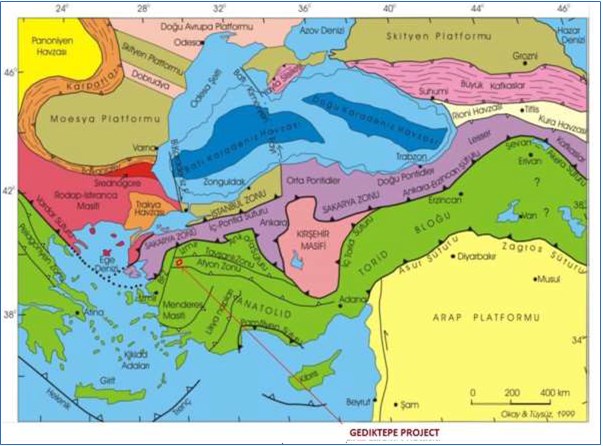
Figure from OreWin, 2019; after Okay & Tüysüz, 1999
Figure 7-1: Tectonic Map of Turkey
The Gediktepe regional geology comprises Upper Paleozoic metamorphic rocks and Lower to Middle Miocene intrusives and volcanics.
The metamorphic rocks are generally composed of gneiss, schist, mica schist, chlorite schist, phyllite, amphibolite, marble, and quartzite, with varying degrees of metamorphism. These metamorphics are stratigraphically overlain by Triassic carbonates and fragmental units, Jurassic limestone, and upper Cretaceous ophiolitic mélange. The upper Cretaceous ophiolitic mélange consists of flysch facies units, including olistostromal blocks and ophiolite sections. Grey colored, recrystallized limestone olistolites and primary rock surrounds maroon-grey colored sheared sandstone and shale. Magmatic rock intrusions developed later between the Oligocene and Lower Miocene, due to extensional features in western Anatolia. Those intrusions cut the Paleozoic metamorphic and Upper Cretaceous ophiolitic rocks, establishing in the region what is now called the Alaçam Mountains granites, which outcrop in an arc-shaped geometry over an area of nearly 30 km2 (Figure 7-2).
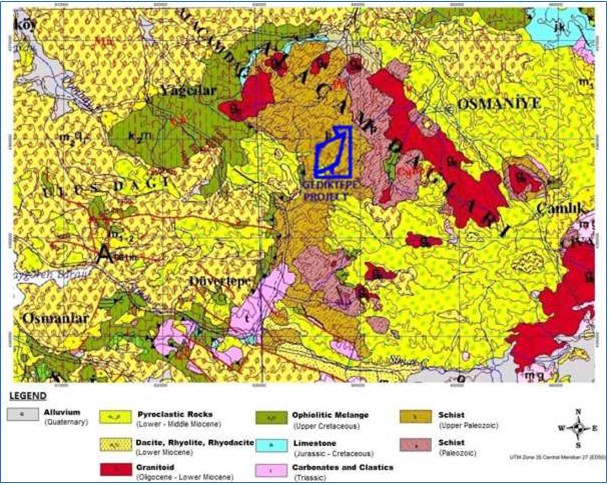
Figure from OreWin, 2019; after Okay & Tüysüz, 1999
Figure 7-2: Gediktepe Regional Geology
The Alaçam Mountain granites consist of granite porphyries and aplitic dykes, creating hornfelsic belts where they intruded Paleozoic metamorphic rocks. Skarn formations are abundant at the contacts of recrystallized limestone blocks of Upper Cretaceous ophiolitic mélange.
Lower Miocene volcanic rocks are positioned stratigraphically above Paleozoic to Upper Paleozoic metamorphics and Upper Cretaceous ophiolitic mélanges. Lower Miocene volcanic rocks comprise andesitic and dacitic intrusions, domes, lava flows, dykes, and volcanogenic sedimentary rocks.
Volcanic rocks, surrounding the Lower to Middle Miocene Alaçam Mountains, outcrop over an area of hundreds of square kilometres from the towns of Bigadiç to Simav, and from Dursunbey to Düver Hill. The volcanic suite includes ignimbrite of felsic (dacite and rhyolite) composition. Ignimbrites have the widest distribution among felsic volcanic rocks, with thicknesses of up to 350 m to 400 m around the Alaçam Mountains. In some areas, these units are overlain by Pliocene terrestrial sediments and Quaternary alluvial deposits, sourced from the local metamorphics, ophiolitic mélange, granitoids, and felsic volcanic rocks.
Figure 7-3 represents a stratigraphic column of the Project area. Mineralization at Gediktepe is hosted in the Paleozoic units shown at the base of the column.

Figure from OreWin, 2019; after Okay & Tüysüz, 1999
Figure 7-3: Regional Stratigraphic Column
7.2 Deposit Geology
1:1,000 scale geological and structural mapping has been conducted in the Project area, followed up by 1:5,000 scale general mapping to outline the possible structures and alteration features (Figure 7-4).
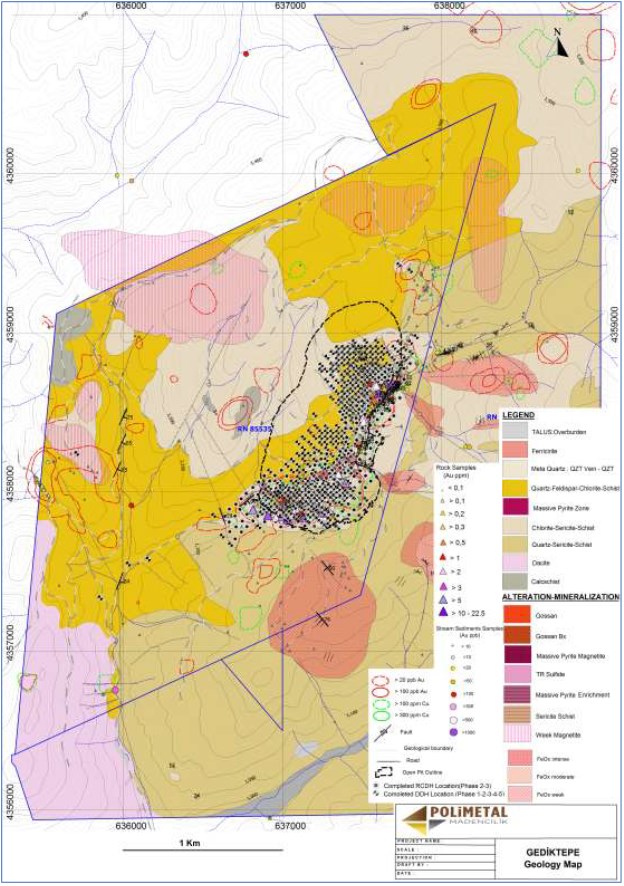
Figure from OreWin, 2019
Figure 7-4: 1:1,000 Scale Project Geological Map
Upper Paleozoic metamorphic rocks are the most common units at Gediktepe, with the stratigraphic sequence, from top to bottom, being:
- Dacite and Pyroclastic
- Calcschist
- Feldspar-quartz schist
- Chlorite-sericite schist
- Quartz schist
The second-most common rocks at the Project are the Lower to Middle Miocene volcanics, observable around Karadikmen Hill, southwest of Gediktepe. These comprise altered dacites-rhyodacites, characterized by lava flows and pyroclastics.
The youngest units at the Project are mineralized gossan and ferricrete, along with talus, colluvium, and alluvium, being weathering products of the host rock.
7.2.1 Dacite and Pyroclastics (Lower-Middle Miocene)
The Dacites and Pyroclastics, of the Lower-Middle Miocene volcanics, are the second largest geological unit at the Project. The volcanics, located at southwest of Karadikmen Hill and Gaşakdoğrusu Hill, contain altered dacite to rhyodacite lava and pyroclastics as illustrated in the following figures:
(Figure 7-5A and Figure 7-5B). The units are grey to reddish color, with a vuggy texture close to the surface, and traces showing flow directions. The vugs are filled with irregular-shaped quartz, and contain much higher amounts of feldspar, quartz, and biotite phenocrysts with depth.
(Figure 7-5C and Figure 7-5D). Macroscopic features of the Dacite include porphyritic texture, large euhedral phenocrysts of clayey feldspar (orthoclase and plagioclase), quartz and biotite (very little chloritization), cemented by feldspar, quartz, biotite, microlite, and crystallite, and volcanic glass. The matrix is intensely clay-altered and iron-oxidized.
(Figure 7-6). Dacite hand specimen.
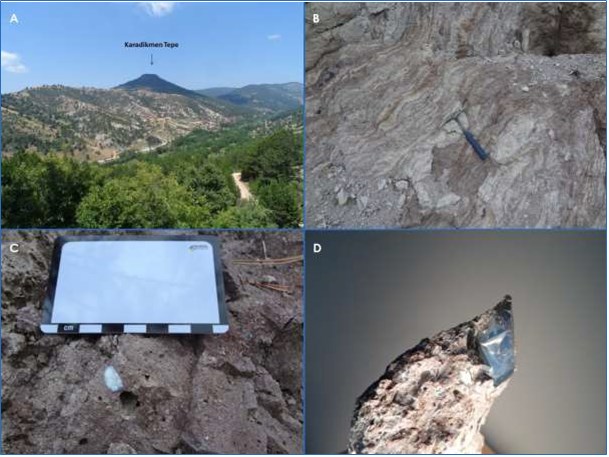
Figure from OreWin, 2019
Figure 7-5: Dacite Features (A): Dacite dome Karadikmen Hill, (B): Flow structure in dacite, (C) and (D): Opal filling in voids
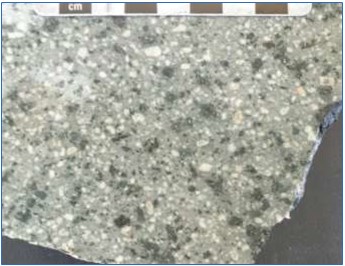
Figure from OreWin, 2019
Figure 7-6: Dacite Hand Specimen. Grey vitreous matrix incl. quartz, biotite, and feldspar phenocryst
7.2.2 Calcshist (Upper Paleozoic)
The Calcschist is observed in outcrop at Küçük Yellice Hill and Fındıkalanı Ridge (Figure 7-7). It is beige to light grey in color, has low hardness and schistosity, and is reactive to hydrochloric acid.
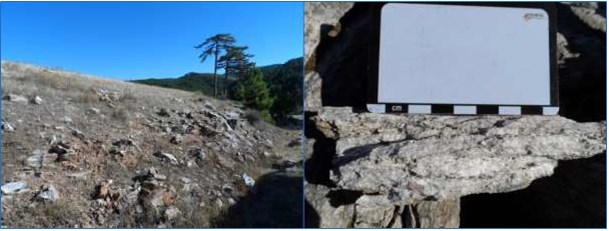
Figure from OreWin, 2019
Figure 7-7: Calcshist in Outcrop. Fındıkalanı Ridge
7.2.3 Quartz-Feldspar Schist (Upper Paleozoic)
The quartz-feldspar schist is beige to light green in color and is observable over a wide area at Gediktepe (Figure 7-8). It forms the primary unmineralized capping over the deposit, and generally contains virtually no sulfides. Macroscopically, it consists of 2-4 mm feldspar and quartz porphyroblasts and can be differentiated from other metamorphic rocks by its relatively weak schistosity. Chlorite and sericite minerals coating feldspar, and quartz porphyroblasts are other rock component minerals (Figure 7-9).
Thin section examination of the quartz-feldspar schist shows high quantities of feldspar minerals (orthoclase, plagioclase) and lesser quartz porphyroblasts. Porphyroblast fragments are composed of interlocked crystals and can reach up to 4-5 mm in size.
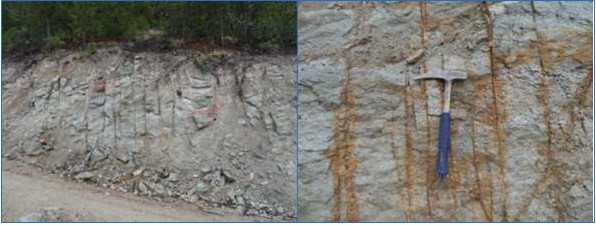
Figure from OreWin, 2019
Figure 7-8: Quartz-Feldspar Schist in Outcrop. Around Büyük Yellice Hill and the Kaynarsu stream
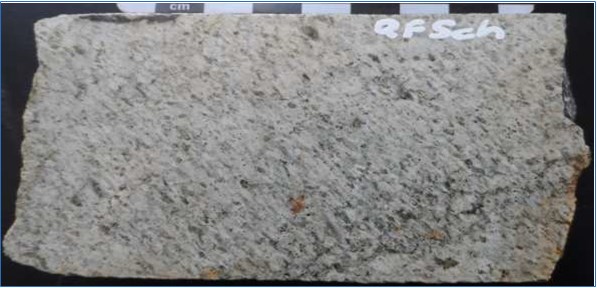
Figure from OreWin, 2019
Figure 7-9: Quartz-Feldspar Schist Core Photograph
7.2.4 Chlorite-Sericite Schist (Upper Paleozoic)
Chlorite-sericite schist is the main mineralization host rock at Gediktepe, marked by gold and silver mineralization in the oxide zone, and copper-zinc-lead with associated gold and silver in the sulfide zone.
The unit is observed in outcrop at Fındıkalanı Ridge, Çamdamı Ridge, Karaismailöldüğü, and northwest of Göğne Hill in the license area (Figure 7-10).
The color of the chlorite-sericite schist varies between green and dark green due to mafic mineral banding. It has macroscopically strong schistosity (Figure 7-11). The orientation of the unit is generally 010-030° (north-northeast) with a dip of 20° to 40° to the north-northwest.
The rock composition, from lower to higher abundance, is quartz, calcite, chlorite, and muscovite-sericite, with euhedral disseminated pyrite minerals observable in some cases. When disseminated pyrite in the chlorite-sericite schists exceed 10% to 45% by volume, the unit is logged by Polimetal (Lidya) as Transition Zone (Tr-Sulf or disseminated sulfide). In Transition Zone material the disseminated pyrite minerals are aligned parallel to schistosity and appear as pyrite bands (Figure 7-11 and Figure 7-12).
Petrographic analysis indicates that the chlorite-sericite schist has been intensely altered (chlorite, epidote), silicified, carbonatized, and mineralized. Fractures and spaces between individual crystals of cataclastic structured epidote are filled with quartz, calcite, and chlorite. The largest euhedral epidote crystal size is up to 1 mm.
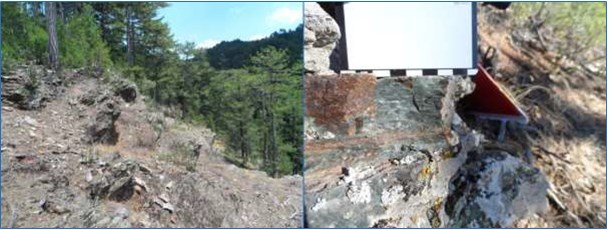
Figure from OreWin, 2019
Figure 7-10: Chlorite-Sericite Schist in Outcrop
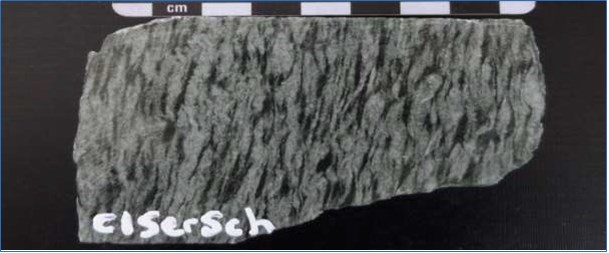
Figure from OreWin, 2019
Figure 7-11: Chlorite-Sericite Schist Core Photograph
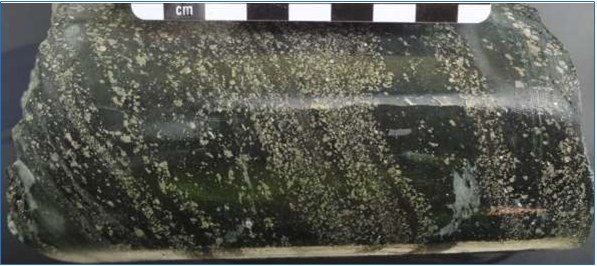
Figure from OreWin, 2019
Figure 7-12: Chlorite-Sericite Schist Altered to Tr-Sulf Core Photograph
7.2.5 Quartz Schist (Upper Paleozoic)
Quartz schist is the lower-most stratigraphic unit at Gediktepe. It can be observed in outcrop in the southern part of the Project area, from Üçoluk Hill to the Aşıdere stream, and in the northeast from Alçakgedik Hill to the Aşıdere stream in the southeast (Figure 7-13).
Macroscopically, the quartz schist is a beige-grey / beige-light green colored unit containing large quartz porphyroblasts. Also, observable are feldspar, chlorite, muscovite, and sericite (Figure 7-14).
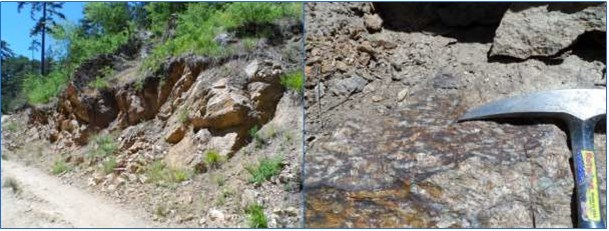
Figure from OreWin, 2019
Figure 7-13: Quartz Schist Containing Quartz Porphyroblasts in Outcrop. Southeast of Alçakgedik Hill
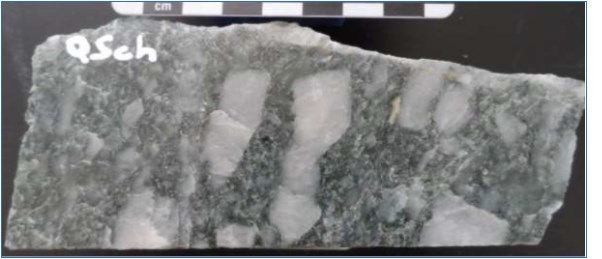
Figure from OreWin, 2019
Figure 7-14: Quartz Schist Core Photograph
7.3 Mineralization
Mineralization at the Project is associated with greenschist facies units that are interpreted to represent massive sulfide deposition that was syngenetic with sedimentary units which are now elongated along a north-easterly trending structure zone and metamorphosed to schist.
Greenschist minerals are generally actinolite, chlorite, albite, and epidote.
The massive sulfide-type mineralization occurs as lens-shaped units trending north-easterly and dipping at approximately 20° to 40° to the northwest. The major minerals of potential economic interest are sphalerite and chalcopyrite. Pyrite is ubiquitous. The units are cut by later north-westerly trending post-mineralization structures within the oxide zone, in which the sulfide mineralization has been completely leached out, leaving gold and silver relatively intact.
Gold-silver-copper-zinc mineralization is present to varying degrees and is divided into five main types, as summarized in Table 7.1.
Table 7.1: Mineralization Type Names
| Horizon | Mineralization Type |
| Oxide | Gossan |
| Sulfide | Massive Pyrite |
| Massive Pyrite-Magnetite |
| Enriched |
| Disseminated Sulfide |
Table from OreWin, 2019
Recent review of interpretations revealed that, in the northern part of the deposit and in the vicinity of the enriched mineralization, areas within the sulfide horizon show high gold and silver and low base-metal (< 0.1% copper and zinc) concentrations.
7.3.1 Gossan (Oxide Mineralization)
The upper portions of the Gediktepe deposit have been weathered, leached, and oxidized by naturally occurring acidic surface water and ground water (Figure 7-15). The natural acidity is due to the presence of sulfides, particularly pyrite, within the oxide zone, and the sulfide mineralization has been completely leached out, leaving gold and silver relatively intact. Relic 'lenses' of high-gold mineralization remain in the oxide zone. There is some evidence that gold mineralization has been transported downwards, chemically, or mechanically, as there is often an increase in gold grade just above the oxide-sulfide contact (Figure 7-16).

Figure from OreWin, 2019
Figure 7-15: Gossan in Outcrop
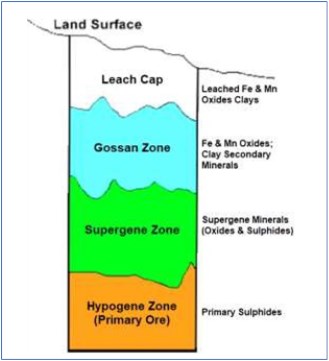
Figure from OreWin, 2019; after Okay & Tüysüz, 1999
Figure 7-16: Typical Profile of Mineralization from Oxide to Sulfide
The base of oxidation is generally abrupt, with rapid changes in metal grade across the oxide-sulfide contact. Copper and zinc grades are typically less than 0.10% within the oxide zone but increase to values typically around 1.40% Zn and 0.80% Cu immediately below the oxide horizon. Gold and silver follow the reverse trend, with gold in the range of 3.0 g/t in the oxide zone and often less than 0.7 g/t at the top of the sulfide zone (Figure 7-17).
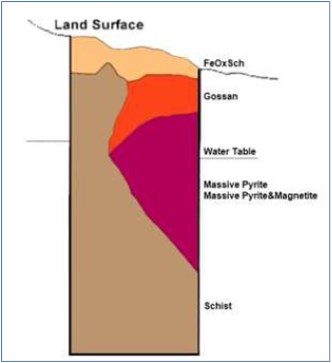
Figure from OreWin, 2019; after Okay & Tüysüz, 1999
Figure 7-17: Mineralization Profile at Gediktepe
The Gediktepe oxide-type mineralization is characterized by yellow-to-red leached zones of intense iron oxide gossan material. Near surface is a leached cap, locally containing elevated gold values.
Figure 7-18 shows drill core through a typical vertical gossan profile at Gediktepe. The base-of-oxide (top-of-sulfide) is generally clearly discernible in drill core and is particularly clear in downhole assay trends.
Macroscopic investigation shows that the most common mineral is limonite with colloform textures, and consists of mostly goethite and, rarely, lepidochrosite.
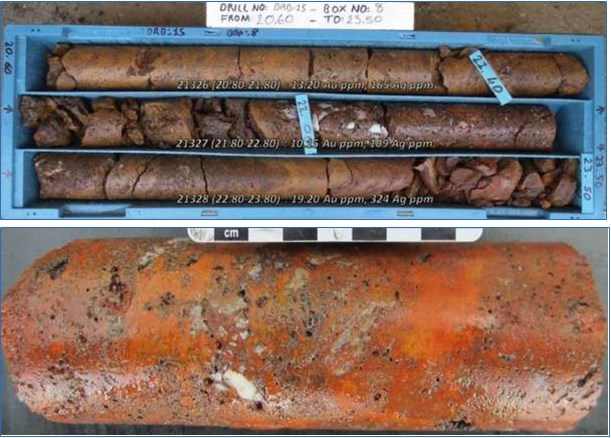
Figure from OreWin, 2019
Figure 7-18: High-Grade Gossan Mineralization Drill Core
7.3.2 Massive Pyrite (MPy)
The massive pyrite zone consists of fine to medium-grained pyrite, with massive-to-banded, vuggy textures, and locally sandy textures near structural features. The sphalerite- chalcopyrite-galena and weak covellite are observed as vug fracture fill and replacement mineralization within a pyrite matrix. Locally, magnetite fragments are observed. The massive pyrite zone hosts high gold and copper mineralization (Figure 7-19), (Çiftehan, 2015).
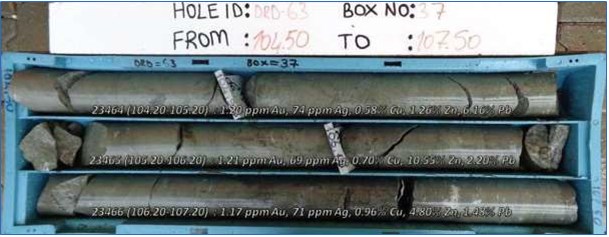
Figure from OreWin, 2019
Figure 7-19: Massive Pyrite Drill Core
7.3.3 Massive Pyrite-Magnetite (MPyMag)
Massive pyrite-magnetite has been distinguished from massive pyrite based on the presence of magnetite. Massive pyrite-magnetite shows the same textures as the massive pyrite. Quartz-magnetite fragments can be seen conformable with the schistosity, or primary bedding structures, within the massive pyrite-magnetite. The massive pyrite-magnetite characteristically shows lower gold-silver-copper-zinc-lead grades than the massive pyrite (Figure 7-20).
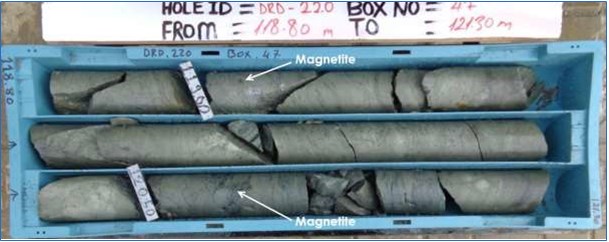
Figure from OreWin, 2019
Figure 7-20: Magnetite Aligned with Schistosity in Core
7.3.4 Enriched (Enrch)
The enriched zone consists mainly of chalcocite-covellite within a fine to medium-grained pyritic mass. Occurring near or along structural features, the enriched zone is generally intensely fractured (Figure 7-21). Relative to other sulfide mineralization zones, the enriched zone contains higher grade gold-silver-copper-zinc mineralization.
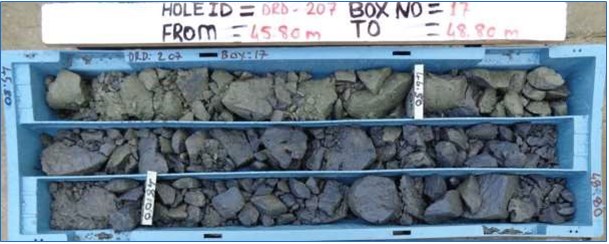
Figure from OreWin, 2019
Figure 7-21: Enriched Mineralization in Drill Core - Blue Color
7.3.5 Disseminated Sulfide Mineralization (Tr-Sulp)
A lower grade sulfide mineralization (gold-silver-copper-zinc-lead) is present within the rich disseminated (pyrite > 10%) chlorite-sericite schist (Figure 7-22). The total sulfide content in this zone exceeds 8.5%. Bands of 1-50 cm thickness appear parallel to bedding in this host rock below and above the sulfide mineralization.
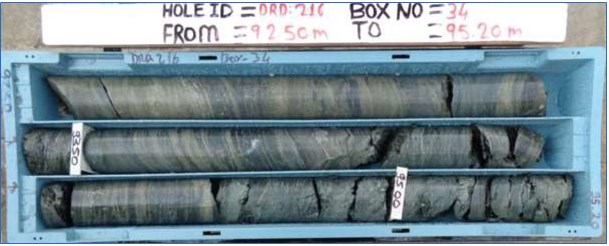
Figure from OreWin, 2019
Figure 7-22: Chlorite-Sericite Schist with Pyrite Veining in Drill Core
7.4 Structure
Structural features are not well mapped at surface due to the extensive ground cover and the degree of weathering of surface outcrops.
Offsets in mineralization and related lithologies observed from drill cores indicate that the mineralization is displaced by a series of steeply dipping north-westerly striking faults.
The tabular mineralized zones, particularly within the sulfide horizon, dip gently to the west. In the north-eastern portion of the deposit, mineralized zones may be shallower dipping. In several locations the overall trend is abruptly terminated, and the tabular mineralized zones are displaced downwards to the northeast, indicating post-mineralization activity.
Progressing north-easterly across the deposit, this displacement geometry has been identified three to four times, and these features have been recognized as abrupt breaks or offsets during interpretation of mineralized bodies.
8. Deposit Types
The characteristics of the Gediktepe mineralization have been interpreted as a convex massive sulfide type deposit, illustrated in Figure 8-1, which implies a syngenetic style of sulfide mineralization. Subsequent weathering and oxidation have been responsible for the development of oxide and gossan horizons.
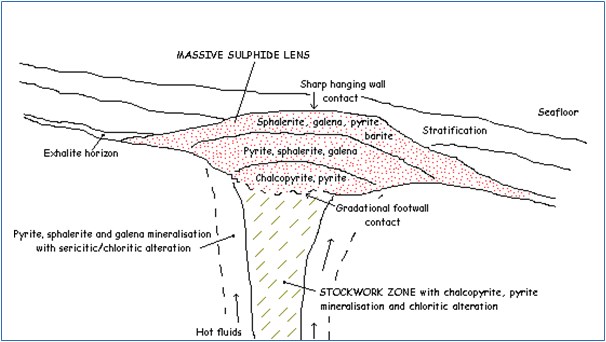
Figure from OreWin, 2019; after Okay & Tüysüz, 1999
Figure 8-1: Vertical Section of an Idealized Convex MS Deposit
9. Exploration
EMX is exempted under Section 9.2(2) (Exemptions for Royalty or Similar Interests) of NI 43-101 from providing this disclosure, as the information required to provide such disclosure is not available to EMX.
Polimetal Madencilik Sanayi ve Ticaret A.Ş. has not conducted any exploration activities at the Property since 2019 Prefeasibility Study. Historical exploration activities are described in Section 1.5.2.
10. Drilling
EMX is exempted under Section 9.2(2) (Exemptions for Royalty or Similar Interests) of NI 43-101 from providing this disclosure, as the information required to provide such disclosure is not available to EMX.
Polimetal Madencilik Sanayi ve Ticaret A.Ş. has not completed any drilling on the property since the 2019 Prefeasibility Study. For a description of historical drilling, please see Section 1.5.2.
11. Sample Preparation, Analyses and Security
EMX is exempted under Section 9.2(2) (Exemptions for Royalty or Similar Interests) of NI 43-101 from providing this disclosure, as the information required to provide such disclosure is not available to EMX.
DAMA's review of the 2019 Prefeasibility Study for sample preparation, analyses, and security suggests that Polimetal's (Lidya's) programs were in accordance with CIM best practice guidelines and NI 43-101 reporting requirements.
12. Data Verification
Polimetal (Lidya) granted DAMA (Sabri Karahan, General Manager, and Mustafa Atalay, Senior Geologist, CPG) and EMX personnel (Eric Jensen, EMX General Manager of Exploration) two limited pre-planned site visits. These site visits were on August 16, 2021, and December 9, 2021. EMX has requested access to technical (e.g., drill hole databases, block modles, mine plans etc.) and other key data (e.g., ESG, permitting, etc.) from Polimetal (Lidya). However, these requests have not been granted. EMX will continue seeking access to key data to further understand the Gediktepe operation's exploration potential, resources and reserves, and anticipated near term and life of mine production schedules.
12.1 Site Visits
During the site visits, DAMA and EMX personnel were escorted at the Project by Hakki Boz, Director of Operations for Polimetal (Lidya) and Oğuz Karamercan, Project Manager for the Gediktepe Mine. Access was given to inspect the site, view facilities, and development progress. At the time of the first site visit, on-going construction was occurring on many aspects of the mine including:
• The mining area was undergoing pre-stripping.
• The leach pad was being lined.
• The Merrill Crowe plant was being framed out.
• The crushing facility and agglomeration circuits (oxide line) were being completed.
• The areas for oxide waste rock were being cleared.
• On site office facilities were under construction.
By the time of the second visit initial mining phases had commenced but commercial production, as defined by the 2019 Share Purchase Agreement detailed in Section 2.1, had not been achieved. Substantial construction progress has been made including:
• The mining area for the oxide ores had been cleared, stripped and initial production was underway from multiple benches in the South and Middle Pits.
• The Phase One leach pad was substantially complete, and oxide ore was being loaded onto the pad. Three 25,000 tonne cells were finished and partially loaded, and work on the fourth cell was progressing.
• The Merrill Crowe facility was largely complete, but several key circuits were not yet operational including the sulfuric acid precipitate wash and mercury retort systems.
• The crusher and agglomerator systems were fully functional.
• The water collection pond beneath the sulfide waste storage facility appeared to be complete and a water treatment plant was being constructed.
• The PLS Pond appeared to be filling.
• The initial doré pour took place on November 6, 2021 (Jensen, 21).
12.2 Limitations
During the site visits, DAMA and EMX were limited to high level field reviews of the Project's status due to the time constraints. No access was given to Project databases or other information during these initial site visits. Per the underlying Gediktepe royalty agreement, EMX's rights to data access are restricted to site visit reviews.
12.3 QP's Comment
A qualified person has not had access to the data to verify the work completed for the PFS16, PSF19, and TR20 reports, including resource estimates, reserve estimates, and production schedules. Significant data compilation, data review, and data verification will be required by a qualified person before this work can be established as current according to NI 43-101 reporting requirements.
13. Mineral Processing and Metallurgical Testing
EMX is exempted under Section 9.2(2) (Exemptions for Royalty or Similar Interests) of NI 43-101 from providing this disclosure, as the information required to provide such disclosure is not available to EMX.
The historical Mineral Processing and Metallurgical Testing which supports PFS16,PFS19, and TR20 is described in Section 6.3.2.
14. Mineral Resource Estimates
EMX is exempted under Section 9.2(2) (Exemptions for Royalty or Similar Interests) of NI 43-101 from providing this disclosure, as the information required to provide such disclosure is not available to EMX.
The PFS19 historical Measured, Indicated, and Inferred Mineral Resources and Measured plus Indicated combined for the Project at specified NSR cut-offs are presented in Section 6.3.4.
15. Mineral Reserve Estimates
EMX is exempted under Section 9.2(2) (Exemptions for Royalty or Similar Interests) of NI 43-101 from providing this disclosure, as the information required to provide such disclosure is not available to EMX.
The PFS19 historical Proven and Probable Mineral Reserves for the Project at specified NSR cut-offs are presented in Section 6.3.5.
16. Mining Methods
EMX is exempted under Section 9.2(2) (Exemptions for Royalty or Similar Interests) of NI 43-101 from providing this disclosure, as the information required to provide such disclosure is not available to EMX.
The PFS19 historical Mining Methods for the Project are presented in Section 6.3.6.
17. Recovery Methods
EMX is exempted under Section 9.2(2) (Exemptions for Royalty or Similar Interests) of NI 43-101 from providing this disclosure, as the information required to provide such disclosure is not available to EMX.
The PFS19 historical Recovery Methods for the Project with some additional information from TR20 are presented in Section 6.3.7.
18. Project Infrastructure
EMX is exempted under Section 9.2(2) (Exemptions for Royalty or Similar Interests) of NI 43-101 from providing this disclosure, as the information required to provide such disclosure is not available to EMX.
The TR20 historical Project Infrastructure for the oxide phase of the Project are presented in Section 6.3.8.
19. Market Studies and Contracts
EMX is exempted under Section 9.2(2) (Exemptions for Royalty or Similar Interests) of NI 43-101 from providing this disclosure, as the information required to provide such disclosure is not available to EMX.
20. Environmental Studies, Permitting, and Social or Community Impact
EMX is exempted under Section 9.2(2) (Exemptions for Royalty or Similar Interests) of NI 43-101 from providing this disclosure, as the information required to provide such disclosure is not available to EMX.
The PFS19 historical Environmental Studies, Permitting, and Social or Community Impact for the Project are presented in Section 6.3.9.
21. Capital and Operating Costs
EMX is exempted under Section 9.2(2) (Exemptions for Royalty or Similar Interests) of NI 43-101 from providing this disclosure, as the information required to provide such disclosure is not available to EMX.
22. Economic Analysis
EMX is exempted under Section 9.2(2) (Exemptions for Royalty or Similar Interests) of NI 43-101 from providing this disclosure, as the information required to provide such disclosure is not available to EMX.
23. Adjacent Properties
EMX is exempted under Section 9.2(2) (Exemptions for Royalty or Similar Interests) of NI 43-101 from providing this disclosure, as the information required to provide such disclosure is not available to EMX.
24. Other Relevant Data and Information
EMX is exempted under Section 9.2(2) (Exemptions for Royalty or Similar Interests) of NI 43-101 from providing this disclosure, as the information required to provide such disclosure is not available to EMX.
25. Interpretation and Conclusions
This Technical Report is principally based on SEDAR filed pre-feasibility studies conducted in 2016 and 2019, as well as an internal 2020 oxide technical report (TR20) provided by Lidya. DAMA has reviewed these reports and conducted two one-day site visits. However, DAMA has not had full access to Project technical and scientific data, and as a result has not been able to independently verify the results of these studies. Notwithstanding, DAMA is of the opinion that the Lidya Technical Reports are reliable, and the information provided in the reports is relevant. Although the Project is sensitive to metal prices and capital cost changes, overall, the economics of the Project as presented were positive and robust. The flowsheets developed for both oxide and sulfide ores from PFS16 and PFS19 are technically appropriate to produce marketable dore and concentrates. TR20 further refines the oxide flowsheet initially presented in PFS16.
See Section 12 for recent observations from DAMA's site visits concerning construction and initial mining of the oxide phase of the Project.
Mineral Resources and Reserves
DAMA is in agreement with the following comments made by OreWin in PFS19.
"The resource classification categories assigned to the Gediktepe estimates (Measured, Indicated, and Inferred) have, at a global scale, identified different levels of confidence (uncertainty) across the deposit, and this is considered sufficient for prefeasibility assessment. However, these categories do not necessarily reflect variations in confidence at a more local resolution, which may impact on the shorter-term effectiveness, and hence profitability, of eventual mining."
Although DAMA concurs with aforementioned, DAMA is of the opinion that a qualified person has not performed sufficient work to classify the PFS19 historical resource and reserve estimates as current mineral resources and reserves. Therefore, DAMA is not treating the PFS19 historical estimates as current. The historical resource and reserve estimates should not be relied upon until verified by a qualified person.
Mining
From DAMA's review, the historical mining studies have determined a robust starter project focusing on the oxide portion of the deposit. It was proposed that mining will take place using conventional truck and shovel operations. Mining will utilize contractor operations employing standard mining equipment under the direction of Polimetal (Lidya) mine staff. Precise pit slope excavation and ability to manage in-pit water will be important to liberate sulfide material found at the pit bottom, as the possibility of a late pushback to recover remaining sulfides will be cost prohibitive.
Process and Metallurgical Test Work
The historical metallurgical test results indicate that Gediktepe oxide ore material is mainly amenable to process by conventional heap leaching with agglomeration and Merril Crowe processing.
DAMA has assumed that Lidya has completed the required additional geotechnical and detailed engineering studies to satisfy the stability of the heap against inherent risks associated with 'clayey' nature of the ore. Polimetal (Lidya) indicated that the clay-like oxide ore will be blended with gossan ore. In DAMA's opinion, it is essential to manage and operate blending for minimizing possible processing risks.
DAMA also notes that slumping is a critical parameter in open pit heap leach operations. Slump characteristics need to be managed by agglomerating ore with adequate cement & lime, which was defined in related test work.
In DAMA's opinion, another risk to be evaluated regarding the oxide process is the accumulation of copper in the leach solution. It should be confirmed that this risk can be eliminated with acid leaching circuit in the Merrill Crowe plant.
For the sulfide ore, the main risk indicated in PFS19 by OreWin was that processing of enriched ore presents challenges due to the pre-activation of zinc in situ, resulting in a relatively high proportion of zinc reporting to the copper concentrate which may be further affected by the weathering of mined ore in stockpiles prior to feeding to the mill. If stockpile residence time is not properly managed for both enriched and ROM sulfide ores the proportion of lower value complex copper concentrate could increase. DAMA is in agreement with OreWin's assessment.
26. Recommendations
Gediktepe Project prefeasibility studies so far have shown that the Project is viable. It is recommended by DAMA that the following points also should be considered for advancing the Project.
Mineral Resources
OreWin recommended in the PFS19 report that additional work be undertaken in an effort to reduce the uncertainty in the current mineralogical model. This may involve some or all of the following activities:
- Additional, focused drilling to upgrade resource classification.
- A short-range variability study to attempt to better understand the grade distributions.
- Selected confirmation resampling and assaying.
- Review of local geological and mineralogical interpretations.
- Refinement of resource modelling and grade estimation procedures and parameters.
DAMA is in agreement with the aforementioned comments made by OreWin. In addition, DAMA recommends that a qualified person should perform, or oversee, data compilation, confirmation twin hole drilling, re-sampling, and data verification so that the PFS19 historical resource estimates can be classified as current mineral resources.
Mining
An update of the reserve estimate is recommended by DAMA based on current operating costs from vendors and suppliers as well as global metal price changes to reflect current market conditions. In addition, DAMA recommends a comprehensive study to update the mine production schedule to better delineate issues that could occur during changeover from oxide to sulfide mining.
Other mining recommendations include:
Since the heap pad was constructed onto the previously established TSF location, the site layout has to be further optimized for sulfide production.
The design of the PAG dump needs to be investigated in more detail and this may identify cost reductions while still maintaining a suitable PAG management methodology.
DAMA is in agreement with the following comments made by OreWin in PFS19.
"The uncertainty in the mineralogical interpretations may necessitate that sampling for grade control be close-spaced and of a high degree of accuracy. A detailed plan in regard to grade control measures is required. To arrive at the most appropriate grade control strategy, studies into the accuracy and practicality of the various available measures should be undertaken, including, but not limited to, blasthole sampling, RC drillhole sampling, trenching, grab sampling, and portable XRF sampling, as well as methods for obtaining accurate and meaningful mapping data from already-mined benches. The feedback of this information into the grade control model in a timely and accurate way will be very important to ensure that knowledge in regard to the tenor and type of mineralization that is due to be imminently exposed is available in a usable form when required."
Mineral Processing
The following activities are recommended by DAMA relating to the oxide ore processing:
- Develop an operation, monitoring, and surveillance plan for the heap leach to guide facility operators with environmental and geotechnical-safe operations of the facility.
- Maintain close monitoring on copper values in the leach solution.
- Optimize leach conditions (irrigation rate, reagent consumptions etc.).
The following activities are recommended by DAMA relating to the sulfide ore processing:
- Complete the feasibility level study.
- Develop designs, drawings, and technical specifications to levels that are ready to be Issued for Construction.
- Update the economic model with higher level of sensitivity as the above information becomes available
Data Verification
DAMA recommends that EMX continue to request access to all technical, scientific, and other key day from Lidya (Polimetal) to improve its working knowledge of the Gediktepe mining operation as a material royalty asset of the Company.
27. References
Bener, 2021. Gediktepe Mining License by Gozde Esen Sakar of Bener Law Office. August 16, 2021.
Çiftehan, H., 2015. Gediktepe Project - Weekly/Monthly Reports.
Canadian Institute of Mining, Metallurgy and Petroleum (CIM), 2014. Definition Standards for Mineral Resources and Mineral Reserves. Adopted on May 10, 2014 (CIM Definitions).
IMC, 2016. Technical Report, Prefeasibility Study, Gediktepe Project, Balıkesir Province, Turkey. Prepared for Polimetal Madencilik Sanayi ve Ticaret A.Ş. by Independent Mining Consultants, Inc., 1 June 2016.
Jensen, 2021. Eric Jensen, General Manager of International Operations. EMX Royalty Corp. Personal Communication. Email. August 17, 2021.
Karamercan, Oğuz Atıl, 2020. Gediktepe Project Oxide Technical Report. Prepared for Polimetal. (TR20).
Okay, A.I, ve Tüysüz, O., 1999. Tethyan sutures of northern Turkey. In The Mediterranean Basins: Tertiary extension within the Alpin Orogens (eds. B. Durand, L. Jolivet, F. Hortvath and M. Seranne) Geological Society of London, Special Publication 156 p.155-178.
OreWin, 2019. Technical Report, Prefeasibility Study, Gediktepe Project, Balıkesir Province, Turkey. Prepared for Alacer Gold Corp. by OreWin Independent Mining Consultants., March 2019.
28. Certificate of Qualified Person
The effective date of this Technical Report is February 1, 2022.
The undersigned were responsible persons for preparing or supervising the preparation of this Technical Report.
 | | March 21, 2022 |
Mustafa ATALAY, M.Sc., CPG. Senior Geologist, Dama Engineering.
| | Date |

| | March 21, 2022 |
Metin ALEMDAR, M.Sc., MIMMM
Senior Mining and Mineral Processing Engineer, Dama Engineering.
| | |
 | | March 21, 2022 |
Selim YILMAZ, M.Sc., MIMMM Senior Mining and Mineral Processing Engineer, Dama Engineering. | | Date |

| | March 21, 2022 |
Arif Umutcan GELİŞEN, B.Sc., MIMMM Senior Mining and Mineral Processing Engineer, Dama Engineering | | Date |
CERTIFICATE OF QUALIFIED PERSON, MUSTAFA ATALAY
This certificate applies to the technical report prepared for EMX Royalty Corporation "EMX" entitled: "Gediktepe Project NI 43-101 Royalty Technical Report" signed on March 21, 2022 the "Technical Report") and effective February 1, 2022.
I, Mustafa Atalay, CPG., as an author of the Technical Report, do hereby certify that:
| 1) | I am currently employed as Senior Geologist in the consulting firm Dama Mühendislik A.Ş, Ankaralılar Cad, Azatbey Sitesi, No:17, 06810, Çayyolu, Ankara, Turkey; |
| | |
| 2) | I graduated from the Hacettepe University (Ankara City) in 2003 with a Bachelor of Science (Applied) degree in Geological Engineering and Hacettepe University, Ankara, Turkey, in 2006 with a Master of Science degree in Mineral Exploration; |
| | |
| 3) | I am a member of the American Institute of Professional Geologists (AIPG) (CPG#11874), I have enough experience in geological mapping, geological data capturing and handling, planning and supervision of drilling program, and reporting. In addition, I have some additional experience in computer-based resource estimation as well; |
| | |
| 4) | I have not visited Gediktepe Project site; |
| | |
| 5) | I have read the definition of "qualified person" set out in the National Instrument 43-101 - Standards of Disclosure for Mineral Projects ("NI 43-101") and certify that, by reason of my education, affiliation with a professional association, and past relevant work experience, I fulfill the requirements to be an independent qualified person for the purposes of NI 43-101; I am independent of EMX and related companies applying all of the tests in section 1.5 of National Instrument 43-101. I have had no prior involvement with the Gediktepe Project; |
| | |
| 6) | I am independent of the issuer as independence is described in Section 1.5 of NI 43-101; |
| | |
| 7) | I am the co-author of this Technical Report and responsible for Section 1, 2, 3, 4, 5, 6, 7, 8, 9, 10, 11, 12, 14, 25, 26 and accept professional responsibility for these sections of this Technical Report; |
| | |
| 8) | I have not had prior involvement with the subject property; |
| | |
| 9) | I have read NI 43-101 and the sections of the Technical Report under my responsibility have been prepared in compliance therewith; and; |
| | |
| 10) | DAMA Mühendislik A.Ş was retained by EMX to prepare a technical report of the Gediktepe Project. In conducting our audit, analysis of the project technical data was completed using CIM "Best practices" and Canadian Securities Administrators National Instrument 43-101 guidelines. The Technical Report is based on a review of project files. |
| | |
| 11) | I have not received, nor do I expect to receive, any interest, directly or indirectly, in the Gediktepe Project or securities of EMX. |
| | |
12)
| At the effective date of the Technical Report, to the best of my knowledge, information and belief, the Technical Report contains all scientific and technical information that is required to be disclosed to make the Technical Report not misleading. |
Ankara, Turkey,
March 21, 2022 | Mustafa Atalay ["signed and sealed"] Mustafa Atalay, M.Sc., CPG Senior Geologist | 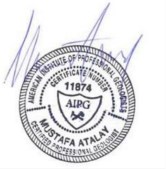 |
| | | |
CERTIFICATE OF QUALIFIED PERSON, METİN ALEMDAR
This certificate applies to the technical report prepared for EMX Royalty Corporation "EMX" entitled: "Gediktepe Project NI 43-101 Royalty Technical Report" signed on March 21, 2022 the "Technical Report") and effective February 1, 2022.
I, Metin Alemdar, M.Sc., MIMMM, as an author of the Technical Report, do hereby certify that:
| 1) | I am currently employed as Senior Mining and Mineral Processing Engineer in the consulting firm Dama Mühendislik A.Ş, Ankaralılar Cad, Azatbey Sitesi, No:1/14A, 06810, Çayyolu, Ankara, Turkey.; |
| | |
| 2) | I graduated from the İstanbul Technical University (ITU) (Istanbul, Turkey) in 1983 with a Degree of Bachelor of Science in Mining Engineering, and in 1985 obtained a degree of Master of Science in Geotechnical Engineering Department of University of Newcastle Upon Tyne (Newcastle, England). |
| | |
| 3) | I am a Certified Professional Engineer (IOM3- 677303) with the Institute of Materials, Minerals and Mining which is a recognized overseas professional organization as listed by the Engineering Council of UK. I am mining engineer with over 36 years of experience in design, implementation, and project management of mineral processing plants. Additionally, I have experience in various open pit mining and design and optimization studies of different minerals. |
| | |
| 4) | I have not visited the Gediktepe Project site. |
| | |
| 5) | I have read the definition of "qualified person" set out in National Instrument 43-101/Regulation 43-101 ("NI 43-101") and certify that by reason of my education, affiliation with a professional association (as defined in NI 43-101) and past relevant work experience, I fulfill the requirements to be a "qualified person" for the purposes of NI 43-101. |
| | |
| 6) | I am the co-author of this Technical Report and responsible for Section 1, 2, 6, 18, 19, 20, 23, 25, 26 and accept professional responsibility for these sections of this Technical Report; |
| | |
| 7) | I have not had prior involvement with the subject property. |
| | |
| 8) | I have read NI 43-101 and the sections of the Technical Report under my responsibility have been prepared in compliance therewith; and |
| | |
| 9) | That, as of the effective date of the Technical Report, to the best of my knowledge, information and belief, the sections of the Technical Report under my responsibility contains all scientific and technical information that is required to be disclosed to make the Technical Report not misleading. |
Ankara, Turkey,
March 21, 2022 | Metin ALEMDAR ["signed and sealed"]
Metin Alemdar, M.Sc., MIMMM
Senior Mining Engineer |  |
| | | |
CERTIFICATE OF QUALIFIED PERSON, SELİM YILMAZ
This certificate applies to the technical report prepared for EMX Royalty Corporation "EMX" entitled: "Gediktepe Project NI 43-101 Royalty Technical Report" signed on March 21, 2022 the "Technical Report") and effective February 1, 2022.
I, Selim Yılmaz, M.Sc., MIMMM, as an author of the Technical Report, do hereby certify that:
| 1) | I am currently employed as Senior Mining and Mineral Processing Engineer in the consulting firm Dama Mühendislik A.Ş, Ankaralılar Cad, Azatbey Sitesi, No:17, 06810, Çayyolu, Ankara, Turkey.; |
| | |
| 2) | I graduated from the Middle East Technical University (METU) (Ankara, Turkey) in 2012 with a Bachelor of Science degree in Mining Engineering, in 2016 with a Master of Science degree in Mineral Processing (METU, Ankara, Turkey). |
| | |
| 3) | I am a Professional Member (IOM3- 681569) of the Institute of Materials, Minerals and Mining which is a recognized overseas professional organization as listed by the Engineering Council of UK. I have been with DAMA for 10 years where directly involved with project feasibility studies, process design and evaluation, equipment procurement, construction management, commissioning, project start-up. Additionally, at different level studies report I was responsible for mining section of these report incudes: open pit optimization, pit design and scheduling and international standard compliant reserve estimation. |
| | |
| 4) | I have not visited the Gediktepe Project site. |
| | |
| 5) | I have read the definition of "qualified person" set out in National Instrument 43-101/Regulation 43-101 ("NI 43-101") and certify that by reason of my education, affiliation with a professional association (as defined in NI 43-101) and past relevant work experience, I fulfill the requirements to be a "qualified person" for the purposes of NI 43-101. |
| | |
| 6) | I am the co-author of this Technical Report and responsible for Section 1, 2, 6, 15, 16, 17, 25, 26 and accept professional responsibility for these sections of this Technical Report; |
| | |
| 7) | I have not had prior involvement with the subject property. |
| | |
| 8) | I have read NI 43-101 and the sections of the Technical Report under my responsibility have been prepared in compliance therewith; and |
| 9) | That, as of the effective date of the Technical Report, to the best of my knowledge, information and belief, the sections of the Technical Report under my responsibility contains all scientific and technical information that is required to be disclosed to make the Technical Report not misleading. |
Ankara, Turkey,
March 21, 2022 | Selim YILMAZ ["signed and sealed"]
Selim Yılmaz, M.Sc., MIMMM
Senior Mining and Mineral Processing Engineer |  |
CERTIFICATE OF QUALIFIED PERSON, ARİF UMUTCAN GELİŞEN
This certificate applies to the technical report prepared for EMX Royalty Corporation "EMX" entitled: "Gediktepe Project NI 43-101 Royalty Technical Report" signed on March 21, 2022 the "Technical Report") and effective February 1, 2022.
I, Arif Umutcan Gelişen, B.Sc., MIMMM, as an author of the Technical Report, do hereby certify that:
| 1) | I am currently employed as Mining and Mineral Processing Engineer in the consulting firm Dama Mühendislik A.Ş, Ankaralılar Cad, Azatbey Sitesi, No:1/14A, 06810, Çayyolu, Ankara, Turkey.; |
| | |
| 2) | I graduated from the Hacettepe University (HU) (Ankara, Turkey) in 2015 with a Degree of Bachelor of Science in Mining Engineering, |
| | |
| 3) | I am a Certified Professional Engineer (IOM3- 682387) with the Institute of Materials, Minerals and Mining which is a recognized overseas professional organization as listed by the Engineering Council of UK. I have been with DAMA for 5 years where directly involved with project feasibility studies, process design and evaluation, equipment procurement, construction management, commissioning, project start-up. |
| | |
| 4) | I have not visited the Gediktepe Project site. |
| | |
| 5) | I have read the definition of "qualified person" set out in National Instrument 43-101/Regulation 43-101 ("NI 43-101") and certify that by reason of my education, affiliation with a professional association (as defined in NI 43-101) and past relevant work experience, I fulfill the requirements to be a "qualified person" for the purposes of NI 43-101. |
| | |
| 6) | I am the co-author of this Technical Report and responsible for Section 1, 2, 6, 13, 21, 22, 24, 25, 26 and accept professional responsibility for these sections of this Technical Report; |
| | |
| 7) | I have not had prior involvement with the subject property. |
| | |
| 8) | I have read NI 43-101 and the sections of the Technical Report under my responsibility have been prepared in compliance therewith; and |
| | |
| 9) | That, as of the effective date of the Technical Report, to the best of my knowledge, information and belief, the sections of the Technical Report under my responsibility contains all scientific and technical information that is required to be disclosed to make the Technical Report not misleading. |
Ankara, Turkey, March 21, 2022 | Arif Umutcan GELİŞEN ["signed and sealed"] Arif Umutcan GELİŞEN, B.Sc., MIMMM Mining and Mineral Processing Engineer |  |








































